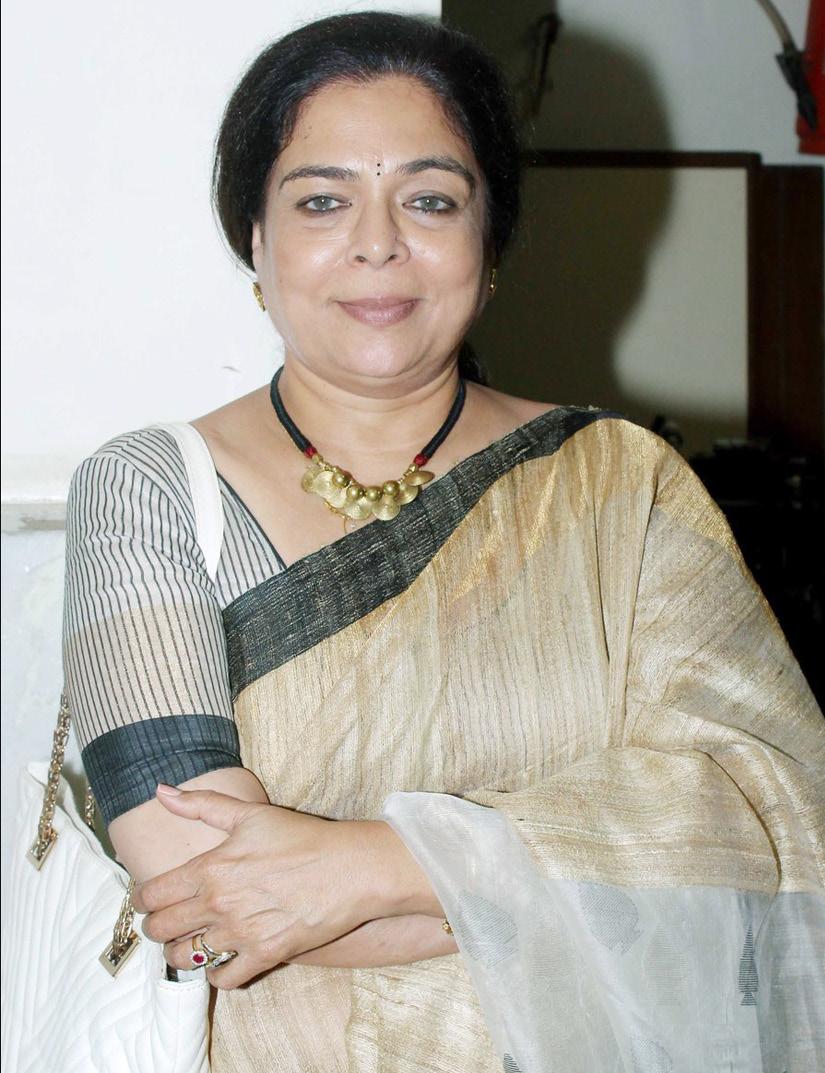

































PUBLISHER





































For his report card, PM Modi will be scoring an A, missing out on the highest grade of A+ because of his silence on a number of secular issues. More on that later.
Aneeta Menon, Virat nehru, raka Sarkhel, Frankey Gerard Fernandes, Mohan dhall, Ananya Wakhare, Khushaal Vyas, Sandip hor, Minal Khona, emily itee dewan
ADVERTISING MANAGER




Vivek trivedi 0410 578 146





ADVERTISING
BY PAWAN LUTHRAIt was the change India had to have. The General Elections of 2014 saw the BJP-led NDA party storm into government. With the Congress party seemingly bereft of any ideas and failing to connect with the people of India, the country welcomed the new Prime Minister Narendra Modi gushingly. More than half way through his term, Modi seems to continue to capture the imagination of the voters, if the recent state elections are any indication. His BJP has just scored an emphatic win in India’s most populous state Uttar Pradesh. And this on the back of forming government in its own right in Maharashtra, Haryana, Assam and Manipur. BJP is also in an alliance with PDP to form its first coalition government in Jammu & Kashmir. Other states where it has triumphed include Jharkhand, Uttarakhand and Goa. The BJP has also fared well in municipal and local council elections in a number of other states.
He did not have a high bar to cross when he came to power. Congress looked rudderless with Manmohan Singh as prime minister. The deep linkages of the party to the Gandhi dynasty kept it (and continues to keep it) a hostage to the glory of days past. Modi, with his charismatic public oratory skills and image management, presented as a leader looking to the future rather than wallowing in the past. Modi was perceived to be decisive and bold.
Both these perceptions have proven to be true.

Demonetisation and the introduction of the Goods and Services Tax have been hailed as major achievements. While the jury was out about the effect of demonetisation on the masses, the verdict of the election polls in UP, where BJP stormed into power, seems to have proved the acceptance of the public for this endeavour to fight corruption and black money. The introduction of a GST is also meant to be a game changer which will add value to the economy.
Regarding foreign affairs, Modi has been accused of excessive international

travel. However, India’s ties with the US and Russia, along with Europe and Australia, are probably at their strongest. While relations with Pakistan are still frosty, India is on the charm offensive with its other neighbours such as Sri Lanka and Bangladesh. Against China, India has held its own. It has been public about why it believes that China’s One Belt One Road initiative is exploitative, colonial in its lack of transparency and the way it created unsustainable debt in “partner” countries, and caused environmental damage.
Where the Modi government loses some of its halo though, is its inability to keep law and order in the communal issues of India. Attacks against Muslims and Dalits have increased. Vigilante groups aimed at maximum violence have risen in areas such as Love Jihad (also called Romeo Jihad) and Cow Protection (Gau Raksha). Modi needs to take a more vocal position against the barbaric acts of these vigilante groups who use religion against the people of India. The Sangh Parivar needs to be called out for these violent activities against certain sections of the people.
India heads to the General Elections again in 2019; it will be good if PM Modi can enter the field with an A+ grade.








from per person $101 from per person $121 from per person $251
1/2 hr pre dinner drinks with 4 Indian canapés Traditional Indian style buffet 2 hour superior alcoholic beverage package 1 night accommodation for the Bride & Groom including bottle of sparkling and breakfast for 2 Chair covers and coloured sashes Mandap area at additional cost
Free Parking Discount accommodation packages for large groups
+$130,000 Working From Home
1/2 hr pre dinner drinks with 4 Indian canapés
Upgraded Traditional Indian style buffet 3 hour superior alcoholic beverage package, 1 night accommodation for the Bride & Groom including a bottle of sparkling and breakfast for 2 Chair covers and coloured sashes Mandap area at additional cost
Free Parking
Discount accommodation packages for large groups
3 event package: Sangeet evening buffet, Engagement buffet, Wedding Day Yuvraj package
Fully catered Sangeet ceremony
Fully catered Enagement ceremony including Indian buffet
Fully catered Wedding Day ceremony with all inclusions from the “Yuvraj” wedding package Mandap area for wedding ceremony

FACT: 82% of US Women [and many men] Who Make Over $130,000 Per Annum, Did It Working From Home (ref provided on request)


You can live the life of your dreams – experience enjoyable work -life balance, improved health, financial freedom, and earn the respect of family, friends and the community. To do so, requires that you reject what's "supposed" to be... in pursuit of what could be.
This is a call to all enterprising individuals, aged 20 and above, to discover a simple, proven way to earn enviable income through a business concept that rewards you exponentially for the efforts put in Experts refer to it as “the best kept secret of the business world” – one that you can start part-time (while keeping your present occupation) and grow it to a multiple 6-figure income stream that will continue to flow for the rest of your life and beyond!
If you are sceptical, that’s OK (I was, too), but don’t let that deter you from checking out this life-changing business concept because there is no cost or obligation whatsoever to obtain full information. Rest assured it is definitely not some ‘get-richquick’ scheme that promises overnight success without effort.
Other ethnic groups have embraced this concept and many have made millions. As an elite Indian ethnic group, why don’t we replicate their success?
However, we can only work with 10 people at the present time. So, if you are keen to learn about our amazing opportunity, act NOW. Email info@vansco.com.au or ring 0423 389 673 for information. Recognise that if you don’t have, it’s because you don’t act. And if you don’t act, you won’t have. Later becomes never. Call NOW
We asked young Indian Australian women to raid their mums’ wardrobes to create a unique Mother’s Day tribute
The Chindian Diaries wrote: A nice feature about daughters in their mother’s sarees.
Ian wrote: Beautiful saris, and beautiful stories.
Suneela Ramaswamy wrote: You look simple and elegant in the sari, Smitha! What you say is so true, I feel close to my mom when I wear her saris. Miss her so much!
Mamata Hegde wrote: So great. Hats off to your mum, Anu. Lovely sari!
Carmel Caggegi wrote: What a beautiful connection!
Anita Rao wrote: Wow… wish we could somehow showcase their stories for younger generations to learn from.
Kala Raghunath wrote: Vishakha, this is the look and feel that I would expect from a mother’s saree - simple, humble and traditional. My favourite out of the lot.
Preeti Jabbal wrote: Devna and Rajni, like mom like daughter, beauty with brains.
Radhika Pradhan Mathur wrote: Both mums and daughters looking lovely.
Shyamali Sinha wrote: Beautiful ladies in beautiful saris. Amrita, the story behind this sari is an inspiration for our current generation. How sweet, Khyati, this sari is a symbol of your dream!
Nikita Dave wrote: Mum, so many of yours to choose from!
Veena Sudarshan wrote: Very appropriate for Mother’s Day.
Mamata Hegde wrote: So great. Hats off to your mums. Lovely saris.
PAWAN LUTHRA interviewed British director Gurinder Chadha whose new film Viceroy’s House tries to recreate the events that led to the Partition of India
Manisha Bakshi wrote: Love Gurinder Chadha movies, looking forward to this one!
Balvinder Singh wrote: Train from Pakistan. A literally and metaphorically burning June’s chilling reminder of a gory happening in bright colours, which know not their dark shades. Perhaps no colour, even the blackest of the black, can describe the agony my parents would have gone through during those three longest June days of their lives. Stuck with three kids - the youngest just six months old - for three days with scarce food and water, in the Amritsar-bound train whose engine was hijacked at Lala Musa junction, and was guarded, from a surrounding frenzied mob, ready to attack any time, by a handful of armed military persons.
PAWAN LUTHRA reported on the Indian Film Festival and Awards of Australia (IFFAA), supposed to have taken place from May 7-13, which was cancelled due to “terror threats”.
Krish Na wrote: I have a lot of Pakistani colleagues. We sometimes laugh at all these people who emigrate half way around the globe, become Australian citizens and yet find time to hate each other for a foreign country’s politics. I can understand people carrying over love from their countries of birth, but carrying over the hatred too? Ridiculous!
IFFAA Sydney should reveal who the ‘terror threats’ were from. Did they report to cops? It’s a sad affair. Art hijacked by dirty politics.

Kulsoom Bint Abul Fateh wrote: Absolutely spot on. Brush aside the hatred and unite. It’s becoming too politicised.
Ghayaz Khan wrote: Completely agreed.
Virat Nehru wrote: Woah, this is so sad.
The Indian restaurant experience in Sydney leaves a lot to be desired, wrote

KRISHNA NEELAMRAJU
Dhanya Samuel wrote: Totally agree. I have always lamented high and loud the lack of good Indian restaurants in Australia. Agreed there are a few which stand out for food and service but given our vast culture and history, the restaurants are often disappointing.
Anu Kailash wrote: Most Indian restaurants don’t showcase our food. They have things which even most locals won’t like. Why don’t they have some authentic dishes rather than creamy crappy curries?
Dhanya Samuel wrote: Exactly Anu. And the latest example of that is Anjappar which has opened in Melbourne. Some of the items are done well and at least the menu reads differently. But the ambience and service is horrible... and to think the Chettinad region is all about architectural grandeur.
Kane Mistry wrote: Really enjoyed reading this article. This is so true and yes we need good, homely restaurants in Sydney for sure. I had an experience going to the first Indian mobile food trailer, “Lalabhai Sevusalwala”. They have the best pure veg food; though they don’t have a restaurant-style menu with 100 varieties, they stick with consistency in food with quality. The chef and owner of the trailer is so friendly that he talks to almost every customer as though he knows them, and also takes the time to step out of the trailer to get their feedback on food and to make them feel at home by giving personal attention to all customers. He also has Indian street-style seating by providing supermarket milk crates, so everyone can sit down or stay near their car to enjoy with family and kids. If you haven’t been there, it’s surely worth warming yourself in this winter with food and personal attention to detail.
Bhavisha Parmar Bhandari wrote: I agree with the article. Have not found an Indian restaurant that I want to eagerly return to.




Lavleen Jeff wrote: Well written and true!
Dr Shailendra Singh @ShailendraBSing retweeted Indian Link In case any fellow Twitteratis are thinking of opening a restaurant, read this.
Freida Pinto or Jane Krakowski in this coral shimmery number from Bibhu

Mohapatra
Leyla Singh wrote: Freida Pinto!
Aneeta Menon wrote: They both look great, and quite comfy too.
PREETI DAGA reported on inspirational Gayathri Veena maestro, visually impaired Vaikom Vijayalakshmi’s performance for Melbourne’s Indian community at an Indo-Australian Society event

Cherian Daniel wrote: Whatever new record you may break, whichever heights you may reach, if you can’t share the love and talent that God has given to you without transforming the next generation, life is nothing.
Dhanya Samuel wrote: Such an inspiring person.
The growth of the internet is helping some Indians validate their caste prejudices, wrote KRISHNA NEELAMRAJU
Dr Shailendra Singh @ShailendraBSing retweeted Indian Link: Here’s a sign of India being dragged backwards by some dunces.
Virat Nehru wrote: This is really good!
Bola Nat wrote: We are all ONE.
VANDANA joined Indian Link in April to forecast what lies ahead with her tarot readings
Rajiv Anand wrote: This new Tarot readings section is very refreshing indeed. Not only is it aptly expressive, it also captures each reading wonderfully summarised. Great work by Vandana, great work Indian Link!
DAMNEET SAMBHY reported from the 30th annual Australian Sikh Games in Adelaide
Tony Huber @AusCG_Mumbai retweeted Indian Link: Great to see sport connecting diaspora across Asia-Pacific! The Sikh community is one of the oldest & largest Indian subgroups in #Australia
pInk paratha S
Many of you loved this recipe by MYTHILI IYER - helping to successfully trick the kids into eating healthy veggies with pink parathas!
Nisha Sharma wrote: I make beetroot puris for the kids… More delicious and easy. Just use boiled mashed beetroot and garlic with salt+wheat flour and chillies if required.
The high cost of the new parental visas has left those who campaigned for it disappointed, reported SHAMSHER KAINTH

Aman Arora wrote: It’s very disappointing that the federal government has passed the ridiculous fee structure for the long stay parents visas - $20,000 per parent + private medical insurance. If you guys think it’s a rip off, please join together for a protest against it. I hope every one of you will spread this message to all your immigrant friends. Doesn’t matter what background they come from. Please share and let’s protest against the bullying and discrimination being done by the government against all immigrants.
hum paanch: fIve tIme S the pa SSIon!
DHANYA SAMUEL profiled The Fifths, the band wowing Melbourne’s Indian community
Harsha Sree wrote: Thanks Indian Link for featuring The Fifths!



Mihir Unakar wrote: Nice!
Sinbad J Collins wrote: About bloody time! Everyone loves the song in the movie…
budget 2017: a mIxed bag for mIgrant S
PAWAN LUTHRA wrote about the key points from this year’s budget as they relate to migrant communities
Krish Na @IndigoKKing tweeted: Great to know you were in the ‘lock-up’ too. Really good summary of migrant related points.
India’s best-known food personality Sanjeev Kapoor spoke with PREETI JABBAL while on tour in Melbourne
Dr Shailendra Singh retweeted Indian Link: [Using food as an anchor for tourism] is also an area for Fiji/the Pacific to focus on given the abundance of local, naturally grown/caught healthy foods.
SK RESTAURANTS @skrestaurants retweeted: What’s cooking in the world of Sanjeev Kapoor!

Sangramkeshari Padhy @keshari49 tweeted: I really want to meet you!
CARL BUHARIWALA wrote about volunteer-run non-profit Positively Transforming World and their work to improve health and education globally Positively Transforming World wrote: Thank you to Indian Link and Carl Buhariwala for reaching out to us and for discussing and sharing PTW’s work in this interview with founder and director Chirag Lodhia.
Dilip Bhatt wrote: This young man possesses and portrays magnanimity and maturity far beyond his age! So proud of who you are and what you are doing to bring salvation of all sorts to so many!
Chandani Lodhia wrote: That’s awesome! Well done.

Mala Soni Vaitha wrote: Well done!
Respectful Relationships education will tackle the issue of family violence early and change the story for future generations, wrote APARNA ANANTHUNI and DIPANJALI RAO
Senthorun Raj @senthorun tweeted: I spoke to @indian_link on why teaching kids “gender theory” (aka how to treat people with respect) is a good thing.

Alex Bhathal @alexbhathal retweeted Senthorun Raj: This is so great, thank you @indian_link, @senthorun for getting this happening in our communities! @QueerGreensVic Senthorun Raj @senthorun tweeted: ICYMI: I spoke to @indian_link on why schools should teach kids to challenge gender stereotypes and inequalities. Dipanjali @dipanjali retweeted Indian Link: If you believe men & women are defined by biology, the idea that gender is more complicated can seem quite radical @senthorun on Respectful Relshps.
peddlIng love: Srk
Shah Rukh Khan’s TED Talk debut garnered much discussion.
On SAGAR MEHROTRA’s Indian Link Radio show, Sonali Shah
Thakkar wrote: No offence to anyone’s likes and dislikes but I give it to SRK for the way this talk was delivered. He is arrogant and sells what he is best at for money, but wouldn’t we all? He is a self-made mega star, and he does agree, even in this talk, that “with this face” he has achieved what he has - we have to give it to him; it’s more than just luck. It’s his ability. And if you listen to his talks in general you can tell he is a well-read and a witty person. I’m not his biggest fan but do give it to him that he is a great entertainer.
Chandra Kishore wrote: His speech is quite motivating and encouraging, hopefully Indians become aware of the greatness of India and its place in the world.
+ JOIN THE CONVERSATION
> LOG on to your own Facebook or Twitter account
> TYPE “Indian Link” into the search box at the top of the screen and click on the link that comes up
> CLICK ‘Like’ to join the Indian Link Facebook community or ‘Follow’ @Indian_Link on Twitter












The University of Wollongong’s new campus builds on an already thriving relationship between the University (UOW) and the Great South West.

Almost 2,000 students travel from the Great South West to the University’s Wollongong Campus each year to undertake their studies, with almost 7,000 UOW alumni calling the Great South West home. UOW continues to forge strong networks in the region through placement

programs and research partnerships with organisations, including Liverpool Hospital, the Ingham Institute and multinational manufacturing company Daikin.
More at southwesternsydney.uow.edu.au
An Information Evening for Year 12 students and their parents will be held at UOW South Western Sydney Campus, on Tuesday 27 June.
This event is a great way to learn more about the UOW courses offered at Liverpool from 2018 and about UOW’s Early Admission program – which gives Year 12 students the chance to receive their
The top-rated university in NSW is open in Liverpool.
Undergraduate, postgraduate, vocational, and pathway courses in:

– Arts – Business

– Health Leadership & Management
– Information Technology
– Legal Services
southwesternsydney.uow.edu.au
uni offer before they sit their final school exams. Staff from all study areas will be at this event, as well as the Western Sydney Careers Expo and other Information Evenings throughout NSW and the ACT to answer your questions.
For event information and bookings, visit uow.edu.au/future/events or call 1300 367 869.
Join the parent newsletter to keep updated at uow.edu.au/future/school/advise
Indian families have been a part of Australian society for many decades but it is only now we’re beginning to see a reflection of this on screen
Shane: “She caused a bit of a ruckus with some fireworks back home”
Yashvi: “It wasn’t a big deal”

Dipi: “Excuse me, blowing up the Big Emu was most definitely a big deal!”
BY ANEETA MENONIf you’ve noticed something a little different on your screens lately, don’t adjust your sets. What you’re seeing is the expansion of diversity in Australian media. Flick over to the iconic series Neighbours and you’ll be greeted with the welcome addition of Sharon Johal, who has recently joined the cast as Dipi Rebecchi, the wife of Shane Rebecchi.

“We are just another family who have moved to Erinsborough,” Sharon tells Indian Link
alongside Sharon Johal, Olivia Junkeer, Vani Dhir and Scarlett Vas make up the mixed-race Rebecchi family. “I am extremely proud to be a part of such an iconic and progressive show,” Sharon says. “In my view, it reflects the Australian community more accurately than any other Australian television show I am aware of.”

Pursuing a career in acting has not been without its hurdles for Sharon though, as she was not only required to battle against the overwhelmingly Anglo-centric television climate, but also the limitations placed upon her by her own family and their cultural values. Looking back, she says, “They were concerned that I would have limited opportunities for success in the profession in Australia given the lack of diversity on screen at the time, as well as the sheer difficulty of attaining success as an actor
generally - their perceived impossibility of being that “one in a million” that actually got one of the rare jobs available.”
With the lack of diversity in Australian media and advertising being notorious, the initial concerns of Sharon’s parents are not hard to understand.
Indian Australian actress Georgina Naidu played legal eagle Helena Chatterjee in ABC’s Newton’s Law earlier this year and she faced similar difficulties starting out.
“I’ve wanted to be an actor since I was three. When I got into the industry I was naïve and optimistic, not expecting any obstacles. I did youth theatre with St. Martins,” she says. “When I got into the VCA (Victorian College of the Arts) I did see a lack of diversity, but I thought it was due to a lack of actors available. I got a shock when I graduated. The casting people saw me in a particular way, and I found myself becoming pigeonholed. I couldn’t go to just any role. After that first year I became proactive about trying to change.”
A staple of Australian television, long-running shows such as Home and Away and Neighbours have been the pinnacle of reflecting Aussie life back to Australians, and have also become the vehicle by which Australian communities are depicted to those overseas. However, each has come under scrutiny for their limited representation of what Australia “looks” like, with the overwhelming majority of families depicted being of Caucasian, Anglo-Saxon background. At a time when 47 per cent of Australians were themselves born outside Australia or have one parent who was, and with over 260 known languages spoken across Australia, a simple glance at the suburban landscape on television does not reflect reality.
It was Shakespeare’s Hamlet who resolutely announced that the purpose of drama is “to hold as ‘twere the mirror up to nature: to show virtue her own feature, scorn her own image, and the very age and body of the time his form and pressure”. Indeed, throughout history, drama and storytelling have been an imperative tool in documenting and communicating the social, historical and cultural contexts of the time.
Visual media, specifically television, is one of the ways in which our world is reflected back to us. Behind a steady stream of current affairs and news media, television operates in overt ways, such as via reality or news shows, or in subtle ways, through the construction of narratives within scripted comedy and drama series. Television enables us to view the world through the eyes of characters specifically designed to invite audiences to either relate or object to a series of moral and practical dilemmas. This aids in creating our own sense of self, and in no situation is it more crucial to have a representation of ourselves than when presented with the day-to-day trials and tribulations of the community around us, particularly our own neighbours. Knowing this reality and having grown up without seeing people like herself represented on television, Sharon always wanted to be an actor. Taking her parents advice on board, she decided to pursue a ‘sensible’ career whilst not giving up on her dreams.
“I graduated in Law and Commerce and worked as a litigation lawyer whilst still auditioning for acting jobs,” she explains.
“It was definitely easier for me to achieve success as a lawyer. Of course, there are hurdles in equal pay as a woman and promotions, however, generally, if you work hard, you get the results. I truly don’t believe race was a hindrance in working in the legal field. Acting is not like that. No matter how hard you work, it doesn’t equal success, and you can only be successful if not only everything goes right for you in the audition room, but the opportunities have to be there in the first place. The roles that were available to audition for over the years for television and film were few and far between.”
but is the cultural landscape of Australian television finally changing? Johal’s character and that of her family are not the first family of Indian background to have moved to Erinsborough. Back in 2011, the Kapoor family moved to Ramsay Street and were written out in 2013. Why has it taken another four years for a family of Indian background to find a home in suburban Melbourne? Are the roles for actors becoming more or less available as time goes on?
“In terms of diversity on screen and my personal experience with auditions for that work, I believe things have changed positively in the last few years,” Sharon reflects. “The reality is that Indian families have been a part of Australian society for many, many decades so I cannot comprehend any resistance to a reflection of this on screen, and it would be disappointing if there still was.”
In addition to speaking with Sharon Johal, who is currently having a blast on the show, we spoke with Neighbours alumnus Menik Gooneratne, who played the role of Priya Kapoor on the show from 2011 to 2013. During this run, the cast and crew received some negative backlash from small segments of the broader community regarding the casting of an ethnic Indian family. In speaking with Menik, she explains that she’d been actively in the entertainment industry in Australia for ten years before receiving her ‘big break’ on Neighbours.

Despite the controversies at the time, Menik looks back on her time on the series fondly. “As a personal experience, it was absolutely amazing. Everyone is like a great big family.” Of course, the unexpected criticism of a family from an ethnically Indian background was “a bit confronting”, but ultimately it was contained to a “small, but vocal, segment” of the viewership.
What ethnicity were the Kapoor family on Neighbours? Indian? Sri Lankan? When asked about the specific heritage of her character Priya, and whether she was “just generically brown”, Menik laughs and admits that no specific ethnicity had been plotted out for her character and

those in her family, however, the writers “wrote the characters to evolve to suit the actors”.
As her own heritage is a mixture of British and Sri Lankan, Menik approached the character of Priya as being from a similar background. Menik has since relocated to LA where her career has skyrocketed and she is “living the dream.” She is currently on location in New Zealand shooting a science-fiction feature film Mortal Engines based on the highly successful novel by Philip Reeve. On speaking about the future of diverse roles in a rapidly-evolving world, Menik says, “I certainly think the arts are the rebellion, but also from a business perspective, it is good business sense to include diversity in your show.”
One of the most notable shifts from the original Kapoor family to the new Rebecchi family is the shift from a fully Indian(ish) family to a mixed-race one, with Dipi’s husband, Shane, being
Caucasian as opposed to the character of Ajay Kapoor, Priya’s husband, played by Sachin Joab, being of Indian descent. The world has changed considerably since 2013, with the rise of right wing populism, and the re-emergence of white supremacist ideologies. It is therefore interesting that Neighbours has removed one of the most politically contentious images from its screens: the brown male body.
the sub-continental female body has traditionally been associated with a non-threatening, exotic beauty. The brown male, on the other hand, is often associated with less favourable connotations, such as the immigrant job stealer, the unattractive nerd and, at its most nefarious, the terrorist. Overseas, roles for men of subcontinental men have expanded much more broadly, with the success of Aziz Ansari’s Master of None, and BBC’s Class – a spinoff of the iconic Doctor Who series – featuring Ram Singh, the ‘hot jock athlete’ character in a lead role. His character is of visibly Sikh origin, grapples with a disability and is portrayed by actor Fady Elsayed, who is outspoken in calling out Islamophobia. In the US, Rahul Kohli plays the role of Ravi Chakrabarti on the cult series iZombie - a character who appeared at first to be in-line with the stereotypical
‘‘
Indian doctor, but has since evolved as a core ally and a serious love interest to other major characters (as opposed to Kunal Nayyar’s cringe-worthy hopeless-atlove-for-laughs Raj in The Big Bang Theory).
“I think in the writing room the white male is the loudest voice,” says Georgina Naidu. “It is perhaps easier for white males to see a white man with an Indian girl, rather than the other way round.”
Lena Nahlous, Executive Director of Diversity Arts Australia - whose emphasis is on changing the arts landscape to one that is reflective of the social and cultural diversity - tells Indian Link, “At this critical time in Australia’s screen industry, a truly diverse spectrum of content and audiences will be what strengthens, builds and sustains it into the future.”
She goes on to specify, “This goes beyond casting diverse actors or hiring diverse crews,
although this is very important. It is about telling real Australian stories that will enrich our culture and attract audiences from the 31 per cent of us born overseas. The content created through these initiatives also could have a higher propensity to sell overseas, as other diasporic communities connect with these stories.”
As vital as it is to see a wide array of faces on screen, we must also see diverse stories as a result (as opposed to characters who are simply generically ethnic).
“Storytelling is important in breaking down barriers, making connections and creating understanding but storytelling alone is not enough. Who is going to tell these stories? And who is going to make the decisions about which stories are “worthy” of being told?” Nahlous asks. “We need to create opportunities and platforms that enable people from non-white backgrounds to have agency in the screen sector, to create artistic and screen work, to be makers, actors and decision-makers.”
Georgina Naidu felt empowered working on Newton’s Law and having a say in the development of her character. “Having a law degree as well, I’ve been involved in the show since the very inception, doing legal research. Later, as an actor, I began to have input to the Indian elements. Whenever something is culturally inappropriate or clichéd, I’ve addressed it early on. I’ve been against elements that are new age or hippie or stereotypical, and I’ve added a nuance of what I feel is real. (My outlook is) people of colour should get the joke.”
as diversity on-screen expands, we must also be aware of what is happening behind the scenes. “We have never before lived in a time with such high levels of human migration and global interconnection via technology,” Lena Nahlous says. “Our stories are intersecting in ways that never have before and we need the arts to help us make sense of this.”
Brown faces are also beginning to make an appearance in our advertisements, Myer’s Mother’s Day campaign, Queensland Tourism and McDonald’s among them. Advertisers are beginning to see the need to reach out to a broader cross section of their target markets.
Whilst it is undeniable that racially blended families are quite common in Australian circles, it’s worth noting that in terms of overall statistics, they are still a minority when compared to the subcontinental population overall. Given the sparse representation of ethnicity on Australian television, the erasure of a fully ethnic family in favour of a ‘safer’, mixed-race one can be interpreted as problematic - particularly if viewed through the ‘white saviour’ lens, which is a common trope in outdated Orientalist narratives in which Caucasian men meet ethnic women and liberate them from their oppressive communities and away from barbaric men, Nahlous says. Once again, counter-acting these representations overseas are characters such as Priyanka Chopra’s Alex Parrish in Quantico, whose
role as a CIA trainee coming from a CIA training background is as far removed from the stereotype of the submissive subcontinental Indian woman as it gets.
Sharon Johal wholeheartedly agrees about the diversification of roles for women of colour. When asked about her dream role, she confesses, “I would absolutely love to play a lead action hero. A Marvel Comics character would be the absolute dream. She would be strong, smart, independent and complex in her vulnerabilities. She would be a warrior and a lioness, who saves the world.”
Now that is something we can get behind.
As is the case with Neighbours, all representation is undeniably good, and Sharon tells us, “I personally have received immense support and encouragement from the general community. I am aware that a few negative comments have been made online as to race, however, I hope that is a minority speaking, and it doesn’t reflect the general population that is the Australia I know and love.”
When it comes to analysing the television and media landscape, it is also important to consider not just what is being included, but also what is being deliberately left out. Like Sharon and Menik, Lena Nahlous is optimistic about the future of diversity on Australian screens. “If any sector can make change happen the arts sector is one that can - it has the flexibility and creativity to generate interesting conversations and engagement, challenge perceptions and misperceptions in an engaging, emotive, and funny way, but also in a way that leaves audiences challenged.”
It is only when we can look to our screens and see all our neighbours, that we can be proud of genuine progress.
With Rajni Anand LuthraMeet Kirsha Rebecchi (aka Vani Dhir) from the new family on Ramsay Street

As a young child, Vani Dhir had once written on a wish list that she would like to be on television one day.
Well, her dreams have come true with a role in Australia’s longestrunning drama renowned for depicting the good, the bad and the endlessly entertaining lives of the residents of Ramsay Street in suburban Melbourne.
Thirteen-year-old Vani plays Kirsha Rebecchi, the youngest daughter of the newly arrived family in Neighbours

Vibrant and talented, Vani says she is the opposite of the shy, anxious and nerdy character she portrays in the show.
“For as long as I can recollect I have always been a performer, doing random things on stage, at family functions, at home and at school, and I have always wanted to act,” Vani tells Indian Link with confidence belying her age.
“I was happy and thrilled to get this role as I am now doing what I love and enjoying every bit of it,” she reveals.
“I wish I could be filming everyday but I have to go to school,” she smiles wryly.
Vani’s routine varies depending on her shooting requirements.
Some scenes require two to three weeks; others take a day, but all her shoots wrap up in a couple of hours, according to Vani.
The outdoor scenes are shot at Pine Oak Court in Vermont South, the setting of the fictitious Melbourne suburb of Erinsborough and the rest are filmed at Television Studios in Forest Hill.
“My school has been very supportive and I get to catch up with any work that I may miss,” says the Year 8 student at Haileybury in Keysborough.
Vani’s parents Jessica and Mohit Dhir are medical practitioners who moved to Keysborough five years ago from Frankston to be closer to her school.
Vani is the youngest of three siblings. Her sister Sakshi is 22 and brother Sahil is 18.
“We are very happy and proud of Vani,” her mum Jessica says.
“The school has been very supportive and Vani understands that she cannot ignore studies as her primary goal,” she adds, when asked how she feels about Vani’s catapult to fame.
“As parents we sometimes tend to overthink,” Jessica admits. “We had our initial concerns about the impact
on her studies, the exposure and cultural considerations, however, it is working out very well so far.”
According to Vani’s parents she has been entertaining friends and family from a very young age, always initiating and participating in acts, skits and other performances at family events.
“That is the reason we had her enrolled in the Young Australian Broadway Chorus (YABC) stage school through which she got to audition for this role with Talent Company Australia.”
“Vani is super excited about the role and she is very well looked after on the sets. The show crew ensures her safety and wellbeing and we are consulted prior to any scenes that may have unusual or sensitive themes,” Jessica reveals, and her now famous daughter agrees.
“I was really nervous in the beginning but the crew explained everything and we did not dive into shooting from day one. I had an orientation that involved drama classes, costumes, meeting other cast and crew and the director, and a drive around the location of external shoots,” she shares.
Early days of filming were nerve-
wracking for Vani, but she got used to it quickly and developed a great rapport with her onscreen family.
“Sharon Johal (who plays mum Dipi) is amazing and I have connected very well with Olivia Junkeer (sister Yashvi). It’s like we are real sisters,” Vani says enthusiastically.
“It’s great to be part of a family that breaks through stereotypes and depicts the diversity of a multicultural Australia,” the young actress says.
Preeti JabbalAt this crucial time in the industry, a diverse spectrum of content and audiences is what will sustain and build it Lena Nahlous
‘‘ ‘‘menik gooneratne







This
























It’s Friday night. I’m in the back of an Uber with a few friends trying to make our way to the Factory Theatre in Marrickville. It’s raining ferociously and I wonder if we’ll make it in time. Then again, being late to events is understood to be a definitively Indian stereotype. I was doing an admirable job living up to the cliché.
The person inspiring such urgency was none other than Indian comic Vir Das, here in Australia for the first time, bringing his Boarding Das tour to Sydney and Melbourne. Though he has been a well-known entity in India for some time, the recent success of his Netflix special Abroad Understanding and a spot on the late show Conan in the United States, have introduced him to a more global audience. This is evident from the makeup of the audience here to see him live. Yes, there are a lot of Indians, but I’m pleasantly surprised to find a fair spread of other nationalities and cultures as well.
As the spotlight hits the stage, Das appears, a guitar slung across his shoulder, amidst loud cheers and whistles. It has been a long journey, filled with hard work.
When Das first appeared on English stand-up comedy scene in India more than a decade ago, it wasn’t the bustling hub of innovative talent that we find today. There
were no acts like Daniel Fernandes, Neeti Palta or Kenny Sebastian; there was no AIB, TVF, EIC, or the numerous other comedic outfits Indian audiences have become familiar with. Das appeared at a time when the art form was still growing and finding its feet among Indian audiences. Since then, he’s diversified his portfolio, acting in Bollywood films like Delhi Belly and Go Goa Gone as well as penning regular comedic columns for various magazines and publications.

“I think it [stand-up comedy] is finally a viable profession because the novelty factor is gone,” Das says. “Now, you no longer have to be a comedian, you have to be a good comedian. And that’s the phase where real innovation starts to happen. So, right now it’s in that really exciting phase. It’s also that kind of profession where now kids can tell their families that this is what I want to do with my life and they are not as shocked as they would’ve been ten years ago.”
At the outset, it is clear Das isn’t here to mine cheap laughs and just pander to the audience. His goal is a lot more ambitious. His humour relies on active engagement from the audience, and that engagement is not limited to having a tokenistic conversation with a few people in the front row. You actually have a silent, internal dialogue with yourself and with Das on stage. Every time he breaches a somewhat “taboo” area, you question your own stance on the issue he is talking about.
“In terms of talking about the tough stuff, you can’t - when that’s your set listracism, homophobia, you can’t say some trivial shit about racism,” Das says. “You can’t half-arse that discussion. If you’re
going to talk about Islamophobia, you have to talk about Hinduism. If you’re going to talk about Hinduism, you have to talk about sati. Because this is where we are. If we talk about Indians being victims of hate crimes when we go abroad, we also have to talk about the fact that Indians are racist towards visitors who come to India as well. It would be hypocritical to not talk about those things.”
Das is at ease playing with the ‘stand-up’ format and its conventions, willing to change things up from the show becoming simply a talking heads routine. The highlight of the show is a surprisingly delightful, three-minute silent re-enactment from a scene in the Hindu mythological story, the Ramayana.
In between all the topical issues, Das also finds a way to connect with the audience on a personal level. The cultural diversity of his upbringing affords him a unique and insightful perspective on life. The show is sprinkled with personal insights about his childhood, particularly the experience of growing up in a place like Africa, something he hasn’t yet opened up about before.
Where we find ourselves today, in a world full of absurdity – where it is impossible to distinguish fact from fiction – it is a time ripe for intelligent comedy to thrive. What then, is the role of a comic today? You can open the newspaper and just read out a headline and that probably is a punchline to some cruel joke.
“It’s our [a comic’s] job to be able to give you enough visuals to be able to read that newspaper. That’s really all our job is,” says Das.
“It’s not to socially comment, if that
happens, well and good. It’s not to change your perception, if that happens, well and good. And nine times out of ten it is coincidence. That I can tell you. Comedians write these really poignant bits and we think these are the ones that are going to get traction. And suddenly, something else gets traction. Like, in the Netflix special, I never imagined ‘once you go brown, the other colours let you down’ would be the most call worthy line of the special. I had written bits about racism, about homophobia and about religion, but that’s the one that stuck. You can’t plan these things.”
“There’s blurred shit happening everywhere,” Das says. “You’ve got Donald Trump. In India, you’ve got gaurakshaks, you’ve got beef bans. You’ve got Brexit. It’s a crazy world. But who is to say it’s any crazier than how Lenny Bruce felt about the world when he was doing stand-up comedy. Or Richard Pryor felt about the world when he was doing stand-up comedy. It’s the job of a comedian to kind of look around and say, okay all this shit is messed up and I’m going to make light of it.”
At the end of the night your cheeks hurt from all the laughter, but more importantly, you pause and question your own certainties and come away with a renewed appreciation of the diversity in thought, culture and ways of thinking around the world. In that introspection by the audience at the end of the show lies Das’ greatest triumph as a comedian.
Ladies and gentlemen, we finally have an intelligent, subversive Indian comic ready to introduce himself to a global audience. Please welcome, Vir Das.


Every time he breaches a somewhat “taboo” area, you question your own stance on the issue he is talking about
‘‘ ‘‘






Michelle Cahill’s Letter to Pessoa wins the NSW Premier’s Literary Award for New Writing
BY RAKA SARKHELMichelle Cahill’s short story collection Letter to Pessoa has won the NSW Premier’s Literary Award for New Writing. Although an Indian-Australian, like her characters in the collection, Cahill has lived several identities having been born in Kenya, moving to London and then Australia, where she now lives.
The short story collection opens with a letter to Portuguese writer Ferdinand Pessoa. In the letter, she writes, “Flâneur, you’ve made me dream of Lisboa, as if I had roamed its streets with nostalgia, becoming the dramatist or the character of a book in progress. Speechlessly, the city has its way with me, in dreams and theosophy, of black and white mosaic tiles, of slaves and cool Atlantic breezes. Of Afro jazz, pastel facades and Alfonso Pereira. Or perhaps in the poems of Alvaro de Campos. I wonder if they were fabrications or if he lived in you? What ships left the rat-infested harbours transporting poets? What ships are docked within us?”
The letter does not end with the sender’s name. It could be the author herself, or her
alter ego, like the several personas that lived and existed within Pessoa.
Pessoa was born in Lisbon in 1888 and left behind an inheritance of works that includes poetry, fiction, plays, speculations on various topics and a string of alter egos in his fictional works, also called literary heteronyms. These alter egos wrote their own narratives, as if dictating their stories to the author (who was just an instrument for penning them down) and lived separate identities in the author’s persona.
The process is not an unusual one since any author must become their characters to bring out the distinct voices and the fleet of feelings experienced by them. Cahill also assumes such various personalities through her missives to literary thinkers Jacques Derrida, Virginia Woolf, Jorge Luis Borges, Jean Genet and J.M. Coetzee.
Of her heteronyms, Cahill says, “I think my heteronyms are selves of the imagination and equally selves of the real. To write, you become another and you lose yourself.”

In her letter to Virginia Woolf, she writes of motherhood, the struggles of an everyday and a weekend parent in a broken marriage, the one parent who tells the daughter to clean her teeth and checks her Maths homework. To Coetzee, she cheekily asks about the ways in which women of colour are marginalised in literature as they are in life.
Her personas and characters are several. They are her, you, me and the many voices
that live inside us. A psychoanalyst caught in a dream, a queer man with a writer’s block who writes to his heart’s content minutes before he is found dead, a migrant family from Dharamshala, their daughter caught in “the disquiet of not-quitebelonging” or even a cat born on a dusty town near Nairobi. They are often caught in their own shadows chasing happiness, or in between the chaos and the calm, seeking and accepting themselves in the wats of Thailand and alleys of Kathmandu.
A clairvoyant smells of amber, sandalwood and ganja, and rehearses his alchemies and arpeggios in his shed. Old friends, who are one another’s litmus strips, bringing out each other’s peculiarities and eccentricities. Her characters are wisened by the road that taught them of love and losing, and through the stream of consciousness of their minds. They are flâneurs in Barcelona, Lisbon, or in bustling metropolis of a third-world country or in the small balcony of a unit in Dee Why.
Cahill is a strong builder of contexts. Her characters come with a lot of baggage, with a strong sense of their history and geography, flora and fauna, and making sense of the new histories and geographies they inhabit. It is easily reflected in their hyphenated identities and the otherness of their existence.
In one of her interviews, Cahill says, “The sound of language matters to me… I believe prose should be beautiful to read, and by beautiful I don’t mean mellifluous;
knowing where the silences belong is crucial. This voice then, which is not me, carries the narrative.”
It is not surprising then, that an author who understands the silences in words, is able to weave narratives soaking in various layers of their characters and their dreams and misgivings. Her language is vivid with action and adjectives, recreating reality with a lot of perfection. At the same time, it is poetic, vulnerable and inward-looking as she subtly casts lights on how the human mind can cheat and craft its own truth and lies.
Reading her aloud is like sifting through an old box of musty black and white photographs, turning the yellowed, dogeared pages of a favourite yet forgotten novel. She creates these amplified montages as if holding a microscope to life, documenting it and, while she documents it, she magnifies it.


The poetic prose of her stories and its hypertextuality stay with you for a long time and percolate into your mind, often altering or making you conscious of the ways in which you perceive the outside.
Letter to Pessoa is a book you pick on a rainy day and read into the wee hours of the night, and re-read to savour the dimensions and voices, both lofty and faulty, in us.

Her characters come with a lot of baggage, easily reflected in their hyphenated identities and the otherness of their existence
Urgent Need: Male Care Worker for Sri Om Care
Sri Om Care urgently needs a male care worker with disability qualification/ experience for 15 to 20 hours per week in the west. Must have driver’s license and own car. Should be first aid qualified with police clearance. Contact: 0410 759 906 and apply to info@ sriomcare.org.au.
FESTIVAL
Rath Yatra, Sat 27 May 12pm
ISKCON presents the fourth annual Festival of Chariots at Parramatta. Assemble at Prince Alfred Square, (corner Market St and Church St). Free prasadam will be served after the Maha Aarati and Kirtan. Details: iskcon.com. au Contact: Somendra, 0433 242 148.
Festival of Chariots, Sat 1 July
10am
ISKCON and Liverpool City Council present the Festival of Chariots at Liverpool. Assemble at 113 Northumberland St, Liverpool. Free vegetarian feast and cultural show. Contact: Govardhan Das, 9601 0290.
YOGA
Yoga Workshop, Fri 26 May 5.30pm
Join the Indian Consulate General Sydney and Spirit of India for a lecture and live demonstration of yoga including Asanas, Surya Namaskar and basic Pranayama. This Free event will be held at Indian Cultural Centre, Level 2, 265 Castlereagh St, Sydney. Register at: icc2.sydney@mea.gov.in or call 9223 2702 Ext. 224.
STAGE
A Tribute to the Music of Hemant Kumar, Sat 17 June 6.30pm
A concert for lovers of the old Bollywood melodies, Australian Hindi Indian Association presents the wonderful music of the legendary composersinger Hemant Kumar performed by Avijit Sarkar, accompanied by Pushpa Jagadish (on vocals) and backed up by selected musicians from JAZBA. Held at Pennant Hills Community Centre, cnr Yarrara and Ramsay Rd. Proceeds go to the AHIA Seniors Group. Tickets: $20-$50. Contact: Tilak Kalra 0413 753 134 or Avijit Sarkar avijit.sarkar. sydney@gmail.com.
Bharatanatyam Ballet, Sat 15 July 6pm-9pm
Indian artists Revathi & Manasvini, in collaboration with Hamsa Venkat & Samskriti School of Dance, Sydney, present YOGATRAYAM, a confluence of Karma, Gnana & Bhakti Yoga expressed as ‘Laya Nirupanam’, a unique dance theme of India’s classic Bharatanatyam style. Held at The Science Theatre, University of NSW, Via Gate 14 Barker Street, Kensington. All proceeds go to charity, to aid disadvantaged children in care of AIM for SEVA, India. Contact: Sudha, 0431 558 934. Visit: samskritidance.com.
Indian Support Center 2nd Anniversary Fundraiser, Sun 4 June Indian Support Center invites you to its second Anniversary fundraiser event at Parramatta Town Hall. Since inception in March 2015, the Center provides services to a large number of
new settlers, job seekers and victims of domestic violence. A lot of work has gone into supporting people requiring emergency support and also people requiring visas and passport related support for travel to India. After the initial seed capital support from the NSW Government in March 2015, this is a self-funded program. Contact: 0411 335 999 / 0412 92 44 08 or support@indiansupportcenter.org.au.
Men’s Health Awareness Ball, Thurs 15 June, 6.30pm
The 2nd Mens Health Awareness Ball aims to raise awareness for men on important health issues to Get an annual health check-up, and build a rapport with their GP so that they can live longer, healthier lives with their loved ones. Proceeds will go to beyondblue and Foundation 49. Held at The Ballroom, Sheraton On the Park, 161 Elizabeth Street, Sydney. Tickets: Early bird $160 per person. Contact: Bhavisha Parmar-Bhandari, 0411 886 740 or Bhavisha.Bhandari@gmail.com. Visit: menshealthawarenessball.com
Swachh Bharat
Help provide financial support for Swachh Bharat mission through the Sulabh Social Service Organisation. The ongoing campaign invites all persons of Indian origin to generously donate for Swachh Bharat. Donations can be made to Sulabh through Western Union. Bank details are below In favour of: Sulabh International Centre For Action Sociology (SICAS)
Account No: 63012660749,
IFSC Code: SBIN0030262
MICR: 110002347
Name of the Bank: State Bank of India, Branch Name: C 28 Community Centre, Janakpuri, New Delhi-58 Contact: bharatramvasudevan@gmail. com.
National Blood Donation Drive by Sathya Sai International Organisation
Sathya Sai International Organisation of Australia & PNG is again having a blood donation drive and is encouraging all of its members who are able to contribute in this wonderful and much needed service. Giving blood is giving life. What better way to ‘Love all; Serve all’ and honour Sathya Sai Baba. Contact: Mayavan 0404 059 093.
MISC
IABBV Hindi School, Sat 10 June
To mark its 30th anniversary Hindi School presents an evening of fun, entertainment and togetherness at the Hornsby Function Centre Hornsby RSL. Contact: Mala Mehta 0412 283 677.
Hindi Classes Saturdays 2.30pm4.30pm
Located at the Indian Cultural Centre, Level 1, 265 Castlereagh St, Sydney. Hindi classes are $5 per one hour class or $40 for ten classes. Registration is essential as there is a maximum of 20 people per class. Paid parking is available in the vicinity. To register email hindi@indianconsulatesydney.org or contact 9223 2702.
SPIRITUAL
Hindu Council of Australia
Interfaith Forum, Sat 27 May 2pm5pm
An interfaith forum exploring dharmic traditions inspiring peace to the world. Held at Auburn Town Hall, 1 Susan St, Auburn. Free registration at hinducouncil.com.au/interfaith-sydney
Vedantic and Brahmasutra Lectures, Fri 19 May - Thurs 1 June
World renowned philosopher Neemaji Majmudar from Mumbai will deliver lectures on the topics Brhadaranya Upanishad and Adhyasa Bhasyam daily for 14 days. Morning sessions 7am-8am, Evening sessions 7pm-9pm. Held at 8 Boden Avenue, Strathfield. Contact: Dr K. Bala 0488 244 868 or 9798 9673, krishnbala81@gmail. com or Dr R. Krishnan 0403 818 386, ramjikrish@gmail.com.
Bala Samskar Kendra Open Day at Oran Park, Sat 5 Aug 2.30pm
Bala Samskar Kendra opens at Oran Park Public School, 390 South Circuit, Oran Park. All welcome. Learn more about Bharateeya Samskriti through Samskritam followed by afternoon tea. Chief guest Donna Shevlin, Principal, Oran Park Public School. Contact: Akila, 0450 117 372 or visit: vhp.org.au.
BSK/SVP classes, Saturdays 2.30pm-5.30pm
A local initiative of VHP Australia, Bala Samskar Kendra (BSK) holds weekly Sanskrit language lessons as well as a culture and heritage program at Oran Park School, 390 South Circuit, Oran Park. Contact: Akila, 0450 117 372 or visit: vhp.org.au.
Global Organisation For Divinity
Australia Activities at Namadwaar G.O.D Australia gladly informs that Namadwaar, Chanting and Prayer Centre at 44 Oakes Road Winston Hills, is fully operational. All members of the community are welcome to have Darshan of the Lord and participate in Nama Chanting and other programs during the following times: Monday to Friday 9am-10.30am and 6pm-7.30pm. Weekends: 10am-12.30pm and 4pm6.30pm. Visit: godivinity.org.au.
Vedanta classes with Arsha Vidya
Australia
All classes except chanting classes are on Zoom. Contact Shankar Arunachalam on 0403 059 658 or arunachalam.shankar@gmail.com for more information.
Bhagavad Gita, Sundays 6pm
Upanishads, Saturdays 8.45pm Beginners Class, Sundays 2pm Vishnu Sahasranama, Sundays 10am
Vedic chanting classes, Saturdays 6.30pm
Free yoga with Divine Life Society, Tuesdays, 7pm
Swami Uditramanandaji of The Divine Life Society of Australia offers free yoga classes every Tuesday from 7-8.15pm at Strathfield Girls High School. All levels of fitness welcomed. Entrance via Oxford Road. For further details, please
contact Karo: 0413 535 157.
Amma Satsang, 6.30pm-9.30pm, 3rd Saturday each month
Sri Mata Amritanandamayi, or Amma, also known as the hugging saint, is cherished as a humanitarian and spiritual teacher. Mata Amritanandamayi Centre Sydney hosts a monthly program to engage in spiritual practices such as meditation, as well as to conduct communityoriented service projects. Held at Uniting Church Hall, 11 Carrington Ave, Strathfield. Suggested donation is $20 for ashram fundraising. Contact: Mohan 0418 462 687 or visit ammaaustralia. org.au.
Yoga: The way of life, Saturdays 8am; Wednesdays 7pm
A retreat for body, mind and soul, join weekly yoga sessions at Glenwood Public School (Saturdays) or Moorebank Community Centre (Wednesdays). To secure a spot, contact: Meera 0433 125 708, or Ankita 0431 750 991.
Shanti Mission Satsang, Sundays
9.30am
Held at the Shanti Mission Abode of Peace Ashram (1 hour north of Sydney), 45 Kings Road, Cooranbong and also in Sydney at the Henley Community Centre, 2 Crown Street, Henley. Visit: www.shantimission.org.
Contact: 4977 3300.
Fire Pooja
Devotees are invited to attend Vedic fire pooja held at the Shanti Mission Abode of Peace Ashram (1 hour north of Sydney), 45 Kings Road, Cooranbong.
Fire Pooja: Mon, Wed, Thur, Sat & Sun evenings, 6.30pm (time changes to 5.30pm when daylight savings ends).
Dhanvantre Healing Fire Pooja: Mondays & Wednesdays, 9am Sri Maha Narayani Yagam: Every New and Full moon.
Shanti Mission also holds special poojas for feast days. Devotees may sponsor poojas. Visit: www. shantimission.org. Contact: 4977 3300.
Sri Hanuman Pooja, Tuesdays 7.30pm-8pm
Devotees who wish to seek the blessings of Shri Hanuman should join the community at Shri Shiva Mandir, 201 Eagleview Road, Minto, on Tuesday evenings for the reciting of Hanuman Chalisa, reciting Hanuman Kasht Nivaran, Hanuman Aarti and Prasad. Contact: Jagdish Chawla, 0421 376 384 or Priest Arul Muthulkumar, 9820 1094.
Spirit of India Yoga, Saturdays and Sundays
Yoga classes are held in Ryde, Wentworthville, Quakers Hill and Epping. All levels incl. beginners, senior citizens, children’s. To enrol in this 15 week course e-mail spiritofindia2002@ yahoo.com, visit www.spiritofindia.org or contact Suresh 0412 202 182.





















looms large
Considering that the score line in the last round of assembly elections before Narendra Modi’s third anniversary of the assumption of power was 3-2 in the Congress’s favour, one can only say that his approval rating has been average.
True, the final line-up of winners became 4-1 because the prime minister’s factotums were able to dislodge the Congress from its No 1 position in Goa and Manipur with some nimble politicking.
But the fact remains that the supposedly moribund Congress won a handsome victory in Punjab over the Akali DalBharatiya Janata Party (BJP) combine and was initially the largest party in the Goa and Manipur legislatures.
It was the BJP’s overwhelming success in Uttar Pradesh which reinforced Modi’s larger-than-life image. But the reality is more mundane even if the country has been able to emerge from the policy paralysis of the twilight years of the Manmohan Singh government by achieving a more than seven per cent growth rate, up from 5.6 per cent in 2012-13 and 6.6 per cent in 2013-14.
However, the availability of jobs fell to its lowest level in 2015 and 2016 with figures of 155,000 and 231,000 new jobs compared to one million in 2009, which was Manmohan Singh’s best year before Sonia Gandhi’s populism undercut the economic reforms.
The reason for the slow job growth is known. It is the increasing resort to automation by the industries. But with 12 million to 15 million new job seekers entering the market every year, India’s demographic dividend of having a young work force may become something of a nightmare.
If a recent study nevertheless showed that 60 per cent of the respondents thought well of Modi, it meant that a large section of the people have retained their faith in his ability to take the country in the right economic direction.
There may be misgivings about the activities of the saffron militants. But these are probably seen as being isolated incidents which are highlighted by the media and do not affect the average people who are
more concerned about the continuing unemployment rate, which has been noted by 63 per cent of those surveyed, and inflation (66 per cent).
But what has apparently impressed the people the most is the absence of corruption in the higher levels, which was the single most important factor for the Manmohan Singh government’s downfall.
However, as the disquiet about unemployment and high prices show, Modi is still basically on shaky ground which has been camouflaged by his rhetoric and the TINA (There Is No Alternative) factor at the national level although he has faced stiff resistance in several states.
The results in Punjab, in the Karnataka by-elections and West Bengal local body polls have shown that it will take a long time, if ever, for the BJP’s dream of a Congress-mukt (free) Bharat to be fulfilled.
At the all-India level, however, Modi holds almost complete sway, for none of the other parties has measured up to popular expectations.
The Congress has had to depend on Sonia Gandhi again despite her indifferent health because of Rahul Gandhi’s palpable inadequacies; Nitish Kumar has become even more deeply entangled in Bihar’s scamtainted politics; Mulayam Singh Yadav’s main battle is still with his son, Akhilesh; Mamata Banerjee has remained essentially a state-level politician in ideas and personal appeal and Naveen Patnaik appears uninterested in the world outside Odisha.
The forthcoming presidential election will be yet another test of the respective strengths of the BJP and its opponents.
As of now, the former appears to have its nose ahead in the race, especially because of the expected support from the Telangana Rashtra Samithi and the YSR Congress.
But much will depend on who the BJP chooses as its candidate, for it will show whether the party has risen to its stature after three years in power at the Centre to be a genuine national party or is still beholden to its friend, philosopher and guide - the Rashtriya Swayamsevak Sangh (RSS) - for seeing a multicultural nation through saffron-tinted glasses.
In all the appointments to the supposedly autonomous institutions that have been
made so far, the BJP has allowed the RSS to plant its standard-bearers, even if the latter are not known for a wide recognition of their talents.
These devoted saffronites include the heads of such well-regarded institutions as the Indian Council of Historical Research and the Indian Council for Social Science Research. It is an open question whether these institutions will retain their high status once their terms end and not be deemed a “circus”, as the Nobel prize winner Venkatraman Ramakrishnan called the recent science congress.
But irrespective of who becomes the President - whether a deeply-hued saffronite or someone perceived as neutral - the possibility of a second innings for Modi looms large at the end of his three years in office.
His success is based on the image of being a man of development which has remained untainted by the depredations of the gau rakshaks and other Hindu fundamentalists.
Hundreds of Indian techies working as software engineers or providing back office services to global firms are setting up a panIndia trade union to protect their jobs amid layoffs by many IT firms, including Infosys, Wipro, Tech Mahindra and Cognizant.
“We have already filed an application with the Tamil Nadu Labour Department to register our Forum as an all-India trade union to protect our interests, especially jobs, as many IT firms are terminating employees at a short notice without adequate compensation,” Forum for IT Employees (FITE) Joint Secretary Aruna Giri told IANS from Chennai on phone.
Admitting that thousands of IT employees across the country benefitted from well-paid jobs and perks over the years when the going was good, Giri alleged that the IT firms were no longer what they were in the past, as they have started to fire more than hire.
“The need for a common platform is not just to protect our jobs, but guard our rights as citizens under the law of the land. For various reasons, including the nature of the industry, which provides more
services than goods, even employees within a company could not come together to raise their voice or protest exploitation by profitdriven employers, promoters, founders and managements,” she said.
Expressing concern over the manner in which many IT and IT-enabled services (ITeS) firms were giving pink slips to even lateral employees owing to disruptive technologies and sluggish business growth, Giri said the employers should think twice before asking their employees to either resign or face termination at a short period.
“Unlike employees in other formal sectors, like manufacturing and labour workforce in commodity plantations, we do not have trade unions or outside support to address our grievances or concerns. Sudden loss of jobs leads to uncertainty and worry, as our families, including children and parents are dependent on us,” she said.
Without naming IT firms, their promoters or managements, Giri said contrary to the statutory labour laws, hundreds of techies, including those with 10-20 years of experience, were being sent home with 2-3 month salary compensation instead of 11 months and other benefits.
“We (FITE office bearers) are getting 50-100 calls daily from our colleagues in the industry working in Bengaluru, Chennai, Delhi, Hyderabad, Mumbai, and Pune that they were being asked to leave or look out for another job, as they were no longer required due to technology shift, lack of required skills and slow growth,” she said.

As a trade union can be formed even with 100 members, the Forum has submitted about 120 names to the Labour Department to register it as a formal trade body and mediate with employers in the overall interests of the $150-billion IT industry, its eco-system and related sectors.
“Once our union is registered in the next two months and allowed to take up issues with the employers of IT firms, we are confident of getting thousands of techies as members to fight for our rights and others, affected by cost-cutting measures of profitmotive companies,” added Giri.
The Forum has about 1,200 online members and 120 active members, with chapters in nine cities, where majority of IT and ITeS firms are located.
Their identity in society is largely limited to being termed hijras (eunuchs), they are often ridiculed for their appearance, their profession has been reduced to begging and their rights are routinely suppressed.
But Manobi Bandopadhyay, India’s first transgender principal, believes that their status can only improve when the third gender itself raises its voice and demands their rights.
“In most of the cases, they remain ignorant of their rights because of lack of education. A transgender can only be recognised when an individual raises her voice and comes into the limelight,” Manobi Bandopadhyay told IANS.
The Supreme Court in 2014 may have given third gender status to the transgenders, but Bandopadhyay sees little hope for their betterment.
“When the government cannot protect women, how can we expect more for our better future? We cannot expect the government to take the initiative and add rights to the community. Better status can only be achieved after we become more vocal,” the 53-year-old maintained.
Bandopadhyay is currently the Vice Chairperson of the West Bengal Transgender Development Board under the state government and executive council member of Kalyani University.
She recently released a candid biography, A Gift of Goddess Lakshmi (Penguin), written by Jhimli Mukherjee Pandey. The biography compresses her journey from being Somnath to Manobi, and her struggle from winning a war of self-identity within family and society to her becoming of India’s first transgender principal.
The writing in the book is bold, raw, barefaced and brings to fore the darker side of child sexual abuse, of which Manobi too was a victim.
“Sharing my personal life can save lives of many others. Sexual abuse of children happens a lot in India but people don’t disclose it or raise their voices; they like to keep them buried. Truth needs to be spoken and exposed,” Bandopadhyay responded on thoughts that evoked her to encourage the book.
“I showed the courage to come (out) with this and share my story with society. My purpose is to remove the evil notions that persist in the society and writing the book is my effort to do this,” she said.
She maintained that she did not have any second thoughts about her biography and that she was not worried about how it would be perceived by readers.
“Why should I hesitate to write about when I had to face sexual abuse? What I wrote may have happened to many others. I want people to be more aware and alert about sexual exploitation,” Bandopadhyay said.
“People enjoy reading about the scandals of others. My book says it all, from my
childhood days to becoming principal of a college. And if people like reading about my ‘scandalous’ life then I don’t have any problem,” she added.
Though the book is a biography, she dreams of writing an autobiography in her own language, which won’t be in any chronological order and will be a collection of scattered memories.
She thinks the pages (of the biography) are soulless as her ideologies and philosophies are not a part of it.
“My feelings and emotions can be best described by me and cannot be penned by anyone else. The philosophies that I follow cannot be described through translation. There is more beyond the book, all cannot be captured in a book,” she concluded.
Hindu, Muslim wives donate kidney to other’s husband
Human blood holds no narrow sectarian boundaries, was proved when a Hindu and a Muslim woman donated one of their kidneys to the other’s husband at a hospital in New Delhi.
Ekram (29), a resident of Greater Noida, and Rahul Varisht (26), a Baghpat resident, were suffering from kidney ailments and needed kidney transplant.
Since both families had no suitable donor, the men’s lives were at risk. Unfortunately, each wife’s blood group failed to match the husband’s.
Ekram’s wife Razia (24) was B-positive while he was A-positive, whereas Rahul’s wife Pavitra (38) was A-positive but he was B-positive.
“We held separate meetings with both families and informed them that if each woman donates her kidney to the other’s husband, it is possible to save the lives of both patients,” Amit Devra, Senior Kidney Transplant Surgeon at Jaypee Hospital, said in a statement.
Convinced, both wives agreed to donate a kidney to the other’s husband. A fivehour surgery successfully transplanted the kidneys to both patients.
“The successful exchange of kidneys between Hindu-Muslim families indicates human blood holds no narrow boundaries. Only the human mind holds religious reservations and if humanity takes precedence over sectarian concerns,
particularly during medical emergencies, thousands of lives could be saved,” noted Manoj Luthra, CEO Jaypee Hospital. Both the patients are doing well, the doctors said.
The ‘middlemen’ who are changing India’s publishing scene
India’s publishing industry is as ruthless as it is dotted with glitz. With debutant authors often taking years to find a publisher, the journey of the manuscript to a full-fledged book is not a cakewalk. Changing this trend is the rise of literary agents in India.
Commonly known as “middlemen” in the publishing industry, the literary agents offer their expertise to authors to reduce their struggle in getting books published. Take 34-year-old Kanishka Gupta, one of the youngest literary agents in the South Asian belt whose big break came in 2013 with Anees Salim’s book Vanity Bag Gupta’s firm, Writer’s Side, was set up in 2010 and he claimed that his agency has sold more than 500 books to publishers in the last six years.
“In the year 2015, we sold 100 books to the publishers, among which 25 were to HarperCollins. We stress on strong prose and exceptional storytelling skills in fiction, and socially relevant or controversial themes in non-fiction,” Gupta told IANS.
According to him, the publishing industry is not a field which can sustain on funding or investment. “It breathes on goodwill; and agenting in the literary world can survive only on goodwill exercise; it is a relationship-driven world.”
Like Writer’s Side, another agency Siyahi too has been acting as a guide to many authors since 2007. Not just Indian authors, but Siyahi has been bringing good writings from Pakistan, Sri Lanka, the US and Britain to Indian readers.
“An agent acts as a catalyst in all senses, helping with the creative process of writing, liaising with publishers, making sure the book gets promoted well for an author,” Siyahi founder Mita Kapur told IANS.
Until a few years ago, authors did not know much about literary agents. But Gupta says that the change has begun and authors, mostly debutants, are approaching agents
because they assure that a manuscript is turned into a book.
Gupta further said that often a debutant author remains clueless about how to submit a manuscript, which publisher to approach and what the market prospects of the book are.
India’s publishing industry is unstable as the top honchos keep shuffling very frequently and often good scripts do not get published, the agents said.
“Unless one has direct connection with the editors, a writer can end up getting quite a low amount for the book. And here lies the importance of our job. If an author is supposed to make one lakh, we make sure that he gets at least five lakhs for the book,” Gupta added.
And not just the authors, publishing houses too are opening their doors to literary agents.
According to Kapur, a manuscript from agents is an assurance of “quality writing” and also maintaining a smooth relationship between an author and the publisher.
“Publishers are preferring to work through the literary agents because they are very good mediators. From making a copy publishable to its book cover designs, it is on the shoulders of the literary agent,” Gupta further added.
Success does not always knock on their doors and, according to Gupta, no agent - even the top ones - has a 100 per cent success rate.

“Often it is because of differences in opinion. At times, publishers don’t like the book or feel it doesn’t fit their publishing profile. Many times, sales compulsions force publishers to turn down manuscripts they really want to publish,” Gupta said while also adding that smaller publishers are not keen on dealing with literary agents.
“The whole problem of legitimising the role of an agent, settling with payment issues, makes us avoid them,” he stated. Though the agents have made an impact in the publishing industry, some hurdles still remain to be overcome.
“In India, agenting is very tough and difficult to scale because of the menace of direct commissioning wherein authors sign directly with publishers,” concluded Gupta. IANS

Travelling through 20 countries, averaging 30 or 40 kilometres a day, wearing through 12 pairs of shoes, and experiencing threats of beheading, visits from secret police, and a stint in jail.

What began as a two-man, three-year journey, became a one-man, five-year solo mission for Arjun Bhogal - walking from Cardiff, South Wales, UK to Cardiff, New South Wales, Australia.
The idea for the Borderwalk came about in 2011, when Arjun, studying film and television production, and his friend Kieran Rae were in their final year of university.
“We were initially inspired by the millions of people around the world who walk for water on a daily basis,” Arjun tells Indian Link in Sydney.
The adventure was dreamed up by the pair after watching an online video of a man who had converted a car engine to run on something other than petrol and drive it around the world, and another video of a couple cycling around the world.

“My mind kind of put the two things together and I thought, ‘I wonder what it would be like to walk that,’” Arjun says. “What started as a passing comment kind of snowballed…”
From the outset, they wanted to raise money for WaterAid and the Marine Conservation Society, and to raise awareness of borderless issues such as water shortages and overfishing, which affect us all no
matter where we live.
With the pair carrying all their own equipment, including clothes, tents, electronics, food and water, they used backpacks and carts to traverse across 10 countries.
Before the walk began, Arjun was not a keen adventure sportsman. “I was not fit at all. I had this idea that if I could lift my own body weight it’d be fine,” he laughs.
“I had this dream of hanging off a cliff going, ‘I shouldn’t have left!’ I went to the gym a bit, but people who do this kind of thing normally are ex-military or endurance athletes, and we couldn’t have been anything further from that!”
Leaving from outside Cardiff Castle in April 2012, no one could foresee where the journey of Borderwalk would lead.
One of the sponsors requested a route the pair would take to Australia. “We sat down and planned a route,” Arjun recalls.
“And we stuck to it all of four days!”
It became a journey stitched together by myriad people from across the world.
“There are literally hundreds of people from each country who have helped me out along the way,” Arjun says.
The most unexpected person he met on the road was a Russian man called Valentin.
“I went to Russia thinking, ‘I’m going to die’,” Arjun says, gesturing at his tan face. “There was a thing on the road were people in the previous country would always tell you that the country coming up would be terrible for you, but Russia turned out to be lovely!”
After first arriving in Russia, Arjun and Kieran stayed at a guesthouse in a small town where they met Valentin.
“This man knocked on the door, a man
that we later know as Valentin, holding a kilogram of walnuts,” Arjun recalls. “He said, in a thick accent, ‘You are walking, you will need these for strength.’”
Almost a month later, over a thousand kilometres on the other side of Russia, the pair again ran into Valentin.
“In the middle of the day, he just rocks up in a car with his friend. He’d driven a thousand kilometres just to come and have lunch with us!”
As the pair moved into Kazakhstan, they stayed with a friend of Valentin’s. “While we were in Russia, one of our two carts broke, so we were down to one. When we arrived in Kazakhstan, Valentin had sent us a parcel. It was this big crate. We asked the friend, ‘What’s in there?’ And he said, ‘It’s a new cart. Valentin made it for you.’ He had hand-made a cart and then taken pictures of how to assemble it! It was crazy! The
man is a legend.”
Arjun and Kieran documented their bold journey on a blog and social media channels, walking up to 40 kilometres a day between towns and villages, surviving on basic food and searching each day for fresh water.
“We definitely suffered from a lack of access to clean water and sanitation along the way,” Arjun says. “At one point we were suffering from dysentery in the Kazakh steppe.”
The longest the pair went without a shower was three months while trekking through Kazakhstan.
“There was just nothing,” Arjun says. “Every drop of water that we had, that we were able to find in wells or were given through people’s generosity, it was all just used to drink or sort out our food.”
In late 2014, about 18 months after
Arjun Bhogal has trekked across cities, jungles, deserts and mountains on his five-year Borderwalk. He has also been robbed, threatened and kidnapped. But the experience has been life-changing.
leaving Cardiff, the pair were thrown in jail for three days after overstaying in Kyrgyzstan while awaiting Pakistani visas.
Kieran returned to the UK.
“A year and a half in, we’d spent each waking moment together,” Arjun says. “When he went home, it was also the first country where we would have been hitting mountains together. It was the first time I was completely alone in a country and I definitely started feeling a bit lonely. It was in the winter, the snow had started, it was minus 30 or 40 degrees, it was cold and wet.”
But Arjun didn’t give in.
“I can see this situation in the future where I expect, at some point, I will have children,” he says. “One day, I imagine those children will come up to me, and whether they say, they’re not smart enough to do something, or they’re not fit enough
difficult and he had to remain circumspect.
“Every time at a police stop, it would be, ‘here we go again,’” he says. “Going through Europe was a bit weird. In Dover, we had immigration call on me! Somebody had called the police saying there were immigrants walking around. We were a bit bearded, pushing our clothes and our belongings and the police showed up with an officer from immigration. As soon as she heard me speak, she was like, ‘Oh, you’re English! Keep going, whatever you’re doing.”
“I felt like I was pushing my luck with every country I was going to. With Afghanistan, I just kind of got picked up, chewed up and chucked out the other end into Pakistan and then India. In my head, I thought Myanmar is where it would go too far. Immigration didn’t really want you there, it was during the elections
be deported back to the UK or be taken to Kabul and on into Pakistan. And I went with Pakistan.”
Having completed the Borderwalk, and having survived to tell the tale, Arjun’s family have become his biggest supporters - and logistics assistants - but like most parents, there were initial concerns regarding the journey.

“Indian parents around the world want to encourage their children to become engineers or doctors,” he laughs. “For some reason, my mum was set on me becoming a barrister. That was never going to work out. When they’d ask me if I was going to carry on after graduation to go and do my Masters, I had to say, ‘I think I might give the walking thing a go…’ But they got straight on board and have helped no end. There’s two things this wouldn’t have been possible without - my family and the people I met on the road.”
Having never been to Australia before, and walking from Perth to Sydney, joined again by Kieran, Arjun says his favourite place is the Nullarbor Plain.

“Not because of anything on the ground,” he explains. “But when you look up at night, it’s just…next level! I’ve never seen anything like it. I was born in London, grew up around outer London, I’ve never seen a sky like that. I went through Kazakhstan, that was a desert, but it doesn’t exist there either. It’s crazy! It’s just mindboggling!”
When it comes to India, “I really enjoyed North-East India. I’d never really known anything about it. Nobody ever talks about it. Sometimes it’s even cut off when you see a map of India. I got there and it was lovely. Weirdly enough it was the first place somebody took me into their house, in the whole of India.”
The first thing Arjun did when he finished the walk and arrived in Cardiff, NSW, was to have a long sleep.
to do something, I’ll have this story to tell them where two people - who were not outdoor adventurers whatsoever – were able to achieve this one thing. And I think that will be a good story to tell them, and hopefully be inspiring in terms of letting them know that you don’t have to be ‘special’ to achieve something special.”
After Kieran’s departure, going into the mountains, Arjun left the carts behind and carried everything in a rucksack on his back. “I had all my stuff on my back for three years. And I could only carry maybe five litres, which is about a day of waterespecially in a hot country. Every day it was the issue of finding water and making sure to stay hydrated. It became my daily worry.” With regard to being an Indian origin man travelling the world, Arjun says it was
and I was being accused of being ISIS, being interrogated by ten policemen in a monastery, having my passport photo compared to ‘wanted’ men in a folder at lunchtime. It was always a bit tense.”
In Afghanistan he had a gun pulled on him and was kidnapped by the military. “General passers-by told me I was going to get my head chopped off,” he says.
Despite, or perhaps because of, the kidnapping ordeal in Afghanistan, the mountains of the region are the number one place Arjun would like to return.

“I don’t feel like I got enough time there,” he laments. “I only made it a third of the way through and then I got kidnapped in the middle of the night.”
While camped on the side of the road in a dried up river bed, Arjun was making a phone call to his family back home with an update. He saw a 4X4 van pull up and quickly ended the call.
“As soon as I put the phone down, seven men with AK-47s came running from every direction, screaming at me,” Arjun recalls. “I just put my hands up.”
One of them checked his belongings, and then they dragged him up to the main road and threw him into the van and drove off.
“I thought, ‘Oh no, this is the end,” he says. “But then they pulled me out and we were at a military base.”
They took his passport and held him overnight. The next morning he had a sit down with eight Generals who were very angry about his presence.
“But one of them added me on Facebook, so he wasn’t that angry!” Arjun laughs.
“They told me that the Taliban knew of a British national that was walking through the region, so they came to get me before the Taliban did. They gave me two options:
At the moment, Arjun is finding it challenging to get back to day to day life.
“I’m struggling to describe to people what I’ve been doing, the things I’ve seen. Now I’m in this position where there’s no common ground with a lot of people.
Their normal day-to-day stuff is going to work or going to a bar; on weekends they brunch. I can’t really relate to that. For me it’s been, sat in a ditch, had a gun held in my face. All my references are about five years old. So when people say something, I have no idea what they’re talking about.
Arjun describes the scene after arriving at a hostel in Kiev, Ukraine to see people singing and dancing to a song they kept playing on repeat. “This song was completely grating on me. It was the most terrible thing I’d heard in my life. And I asked them, ‘What are you doing? What is it called?’ It was Gangnam Style!”

“I slept for three days,” he says. “I don’t think I had a proper night’s sleep for five years. It’s like when you’re going for a trip and you know you have to get to the airport early in the morning. Every night was always like that. When I stopped I just slept for days.”
On returning to the UK, Arjun wants to pursue work with homelessness and mental health charities, as well as with clean water access groups. “Camping in Asia was more akin to rough sleeping than camping, and that changes everything about you,” he says. “You don’t really sleep, you’re suffering from anxiety and depression, you’re just lonely. It changes who you are and it affects the relationships you have with family and friends you make along the way.”
Arjun has just one question that still keeps him up at night: “I wonder where my stuff that was stolen in Dubbo has ended up!”
Canberra couple Shafeen Mustaq and Monty Feras have been training to walk 250 km for the Simpson Desert Challenge
Canberra couple Shafeen Mustaq and Monty Feras have been training to walk 250 km across the Simpson Desert.
The Simpson Desert Challenge (25 May to 4 June 2017) is an 11-day adventure that includes eight days of trekking in the completely isolated and harsh environment.
The physical and mental challenges are intended to reflect the daily lives of people the walkers will be fundraising for - young Australians with high care needs. The Brisbane-based charity Youngcare (www. youngcare.com.au) which organises the trek is seeking to fund age-appropriate housing for young people with high care needs who currently live in aged care facilities.
Why did Shafeen and Monty choose such an unconventional way of helping other people?
“We are an unconventional couple and unconventional ways appeal to us!” laughs Shafeen. “Really though, we love the great outdoors, we love travelling and we love challenging ourselves, so physical exertion appealed to us. I also romanticised the notion of a desert trek with comparisons to the Prophet’s travels through the desert and
his nights at the cave thinking about life. To walk as a small fragile being in an infinite space and contemplate the universe in an attempt to get closer to God really appealed to me. And lastly, similarly to fasting, taking myself out of the normal comforts of life that I take for granted will help me empathise with those less fortunate and less abled - the recipients of the fundraising.”
Unfortunately, Shafeen has had to pull out only days before the trek, having sustained knee injuries during training. But Monty will continue; his training and experience from when he was in the Bangladesh Army will come in handy to brave the Australian desert.

Shafeen meanwhile, is continuing her fundraising activities. To make a tax deductable donation visit Monty’s Everyday Hero page: simpsondesertchallenge2017. everydayhero.com/au/monty
Monty will spend eight full days and nights in the desert, exposed to the elements, and climb more than 1000 sand dunes.
“Going to the bathroom in the desert will also be a challenge, and trying to avoid snakes and other creepy crawlies!” says Shafeen. “Despite it being winter, the
temperature will get quite high during the day and then drop quite low during the night so that’s a challenge, staying hydrated, warm and cool depending on the time and place.”
23-year-old Shafeen has been highly community-minded since her teens, and has worked with several charities, most notably Probasy, a small NFP which raises funds for the poor and disadvantaged in Bangladesh. She also volunteered for FredHyde.org otherwise known as CO-ID Australia an Australian charity that builds and operates schools in the third world focusing
specifically in poverty and natural disaster stricken areas of Bangladesh.
Currently she is a volunteer with a newly formed Canberra-based charity Sitara’s story which is aiming to raise $5,000 by year end to facilitate the delivery of mental health awareness and training to teenage girls in rural schools in Bangladesh by certified psychiatrists. In addition to this, Shafeen contributes regularly to Indian Link, and also manages a YouTube channel called “Muslim women can” where she researches and presents short videos of revered and renowned Muslim women.
A team from Australia is set to take part in this year’s Mongol Rally
It cost them all of £11.50 - purchased in a London scrapyard - and will drive them all the way from the UK to Mongolia.
You might think that’s crazy, but Melbourne-based accountant Arvind Singh is doing the Mongol Rally this July with his mates from New Zealand, Sid, Raj and Arvind. Their aim - fundraising for charity. And of course, a bit of adventure.
The trip will take 30 days and they will travel some 16,000 kilometres through France, Belgium, Germany, Hungary, Romania, Bulgaria, Turkey, Georgia, Turkmenistan, Uzbekistan, Kazakasthan, Russia and finally Mongolia.
“We wanted to push ourselves out of our comfort zones,” Arvind told Indian Link. “We are in our mid to late 30s, all of us family men, and thought we should do something to live minimally for a few days, interact with people we don’t usually meet and learn from them, and also do our bit for charity.”
Calling themselves ‘Honk Honk Old Monk’, the four will be among 400 teams in the rally. They are fully aware that only about half the teams make it to the final post in Ulaan Baatar, but this does not faze them.
“Our preparations are mostly done for
the 16 July start – visas are arranged and route is mapped out,” Arvind revealed. “We are now hitting the gym to gain fitness to be able to live out of a tiny car for 30 days...”
The team is prepared for the large portion of their route that is not on paved roads, and know that mechanics and even food may be hard to come by. Yet they are aware that it will all be worth it. Not only will they be raising funds for the needy, it might even be life-changing for themselves.
Check them out at www.honkhonkoldmonk.com
Readers can help by making donations to their chosen charities: Cool Earth (www.coolearth.org) a UK-based international NGO that protects endangered rainforest in order to combat global warming, protect ecosystems and to provide employment for local people Starship Foundation (www.starship. org.nz) which provides healthcare services for young kids in New Zealand and the South Pacific


























































































































Indian Prime Minister Narendra Modi has called for a new Chicago to be built every year. Cities require lots of buildings, which is why sand mining, mostly illegal, has exploded across the country as people seek to supply sand to construction firms. The construction boom, however, has revealed an absence of any effective institutional safeguards to govern sand mining. Sand is vital in ensuring India’s groundwater supply, but state government corruption and poorly enforced regulations have allowed “sand mafias”, illegal miners who mine and transport sand, to thrive.
In India, politics and current environmental laws feed the corruption and illegal sand mining operations contributing to the country’s water woes. Running a reputable business in India is extremely hard to do.


According to the New York Times, the existing legal system pushes anybody looking to construct something to issue bribes to the necessary officials.
The World Bank ranks India 130 out of 190 countries for ease of doing business and an awful 185 out of 190 for one’s ability to acquire a construction permit. A possible reason for these figures is that the acquisition of a mining commission does not put legal miners ahead of illegal miners. Permit applicants must wait for long periods of time for applications to be processed and even when a permit is acquired, economically speaking, the business sees no immediate benefits. Commissioned miners must pay for land reconstruction and are not able to expand the size and depth of their mandated operation. It is easier, and more cost effective, to pay a number of bribes up front to politicians, engineers and managers and carry on as an illegal miner.



Such a system is a natural breeding ground for corrupt officials. Politicians have been reluctant to take any concrete measures that address India’s worsening sand, and by extension, its groundwater, situation. Sand mining is a policy area critical to mitigating India’s worsening




























































































groundwater situation, but, politicians, uninterested in the implementation of laws, and institutions to back them up, prefer to ignore the policy problem and make money from it instead. The fortunes to be made through bribery, graft and the facilitation of illegal sand mafias in the sand industry are more lucrative than if they were to implement policies that saved sand. Without officials to reign in miners, who apparently do not care about the health of the rivers they mine, the quality and quantity of ground and surface water, as well as the institutional security of India, is being seriously threatened.
Sand is vital in securing India’s most critical water resource: groundwater. India is the largest user of groundwater with more than 60 per cent of groundwater being used for agriculture and 85 per cent for drinking purposes. Many argue that falling groundwater supplies are due to cheap drilling technologies and the Green Revolution, but sand mining is equally to blame. In the Indian state of Kerala, a river in the village of Manimala has suffered the effects of sand mining. The river running through the village has all but dried up. Sand is a vital component of aquifers, as it acts as a material capable of storing water for later extraction. Without sand, the water table (the upper-most layer of the aquifer) drops. Furthermore, rainfall is not absorbed and rivers do not fill up. Wells run dry and eventually deeper wells that are sunk looking for remaining water fare much the same. Without sand, water cannot be captured. Some have even likened sand mining to water theft. To recharge groundwater levels, sand is a necessary ingredient. Sand acts as a link between the flowing river and the water table and provides structure to the flow of the river and the riverbanks.
Overall, the mining of sand by criminal gangs shows how corruption and ineffective institutions are obstacles to water security that cannot be ignored. India is a helpful reminder that to be water secure, one must be politically secure first.
The mining of sand by criminal gangs in India is doing irreparable damage to the country’s water resources, writes Future Directions International’s BENJAMIN WALSH
Without sand, water cannot be captured: the water table drops, rainfall is not absorbed, wells run dry and rivers do not fill up

Backpacking around the world gives one traveller an insight into his own culture

What’s even more remarkable in the book, is Nazareth’s hunger to find parallel cultures around the world.
clothing! It seemed as though our GoanMumbai Catholic cultures were essentially a parallel society to India’s more mainstream cultures and as an adult, still intrigued by these differences, I went searching for answers to Portugal.”
It turned out, it was like going back to his roots.

“I found many similarities between the Goan-Mumbai Catholic customs and the Portuguese. I also made many interesting discoveries regarding our culture, and drew conclusions as to why the Goan-Mumbai Catholic community was different and essentially a parallel world to mainstream India.”
Nazareth’s What Lies Beyond canvasses other fascinating and curious bits of information about the world and the people that live in it, all while travelling rough.
BY FRANKEY GERARD FERNANDES
Several years ago Indian Link featured Kynsléy Nazareth, a young Indian Australian couch surfing across the world and blogging about it.

Nazareth’s writing based on his travels has now gone beyond cyberspace and into print, with his maiden book, aptly titled What Lies Beyond

Nazareth’s experiences as an Indian backpacker travelling the world are refreshingly different from most travellers, as he makes off-beat observations and travels to places that many people don’t even know exist.




Brought up as a Goan-Mumbai Catholic boy in western India, Nazareth admits he felt like a fish out of water. Mainstream Indian cultures were a radical departure from what he saw and experienced in his Goan-Mumbai Catholic community.
He explains, “We spoke English fluently at home and outside, and my parents justified it as the most widely spoken language in the world. This stood in contrast to the various Indian languages spoken on the street and elsewhere in India. As a quiet and shy child I never spoke my mind, but I was always secretly fascinated by what was going on around me. Such as, why our names are Portuguese or British, or why our women wore dresses, whereas Hindu and Muslim women wore sarees, salwar kameezes or burqas. I wondered why my mother almost never wore traditional Indian
He comes to understand that the best way to unearth the true culture of a place is to be open to the road. He lives with local people everywhere and hitchhikes to get from place to place, sometimes travelling with a cocktail of personalities. He does a stint at a farm, dives into dumpsters for his food and at one point, joins two other young men in asking local stores for free food.
He discovers a place where people meet with the intention of feeling sad together, even when there is no reason for their sadness. He even attends a wedding event where the bride is not present.
He discovers a baffling and gruesome underground world, some of which involves animal brothels in Germany. While in one place, two women broke out into a fight regarding who was taking him home, at another he was mistaken for a paedophile!
The book has been a labour of love for
Dravid

Nazareth and he’s worked at it for around six years. He’s written about 31 countries, including India and Australia. He experienced several challenges during this time, including the death of his mother. Nevertheless, he kept chipping away at writing and completely gave up his social life over the past year to complete the book. The travel as well as the reflections afterwards have brought broad insights in this young person’s mind about his own origins. Nazareth has truly delighted many Indians by including Goan-Mumbai Catholic culture as one of the unique and curious cultures of the world. He has credited the almost-unheard-of community and vividly brought to life the many splendours of its heritage.
What Lies Beyond has been released globally so the stories of the community can be heard far and wide. After all, special experiences do lie beyond the everyday.
Nazareth learns that the best way to unearth the true culture of a place is to be open to the road
Rahul
Much has been written about students who have auditory processing difficulties. Such students find it hard to process aural information and can be distractible. Many teachers believe these students are simply ‘not listening’. After repeated instructions they report such children to be off task and easily distracted.
Whilst this is an issue for parents and educators, there is also an issue with students who DO listen and DO hear - but whose needs are not catered for. This can been seen when observing how students attempt to solve multi-step written problems.
A curious phenomenon has been observed when watching students perform written mathematical problems that require more than one step. For some students, when trying to complete such written problems, they fail to be able to read all of the data provided. This means that they cannot grasp exactly what needs to be done. Their visual acuity is compromised. This can be the case even if they read the question two or three times. They tend to focus only on parts of what is written.
However, when the same students are asked to read the problem out loud, they stress particular words that they had not noticed prior. This makes an immediate difference to their capacity to understand what is being sought in the answer to the question.
This exact scenario has been observed amongst students of all abilities, on numerous occasions where problems are written. Such problems require a translation of the words into the algorithm required to solve the problem.
Educators need to be alert to this phenomenon.
There is a direct relationship between being able to hear what is being read and actually seeing what is on the page. By being able to hear what they are reading, these students tend to bring greater focus. The auditory loop helps them to check for accuracy in what they are reading. This is affirmed when a student says, “Oh, I didn’t notice that word when I read it,” or “Oh, that’s what the question is asking.”
Educators and parents should be aware of the aspect of thinking or cognition called auditory working memory. Auditory working memory includes the capacity to retain aural information and remember information that is heard. This memory function is related to the capacity to process information and to derive meaning from sound. It is therefore extremely important

to problem solving. These students who read out loud are activating their auditory working memory and it is necessary for them to manage the multi-step problems.
In an era when so much attention is being focused on the diversity of learners, understanding that vocalising when reading may be central to understanding is very significant.
It should be clear that these students are very disadvantaged by the expectation that they are not to speak or read out loud in regular classrooms. Indeed, to do so may be seen as a sign of academic immaturity.
Educators should ask, however, whether the restriction on reading out loud is appropriate. They should ponder whether students should be encouraged to read out loud more often, and further, whether examinations should be structured so as to allow students, for whom this is an issue, to speak.
Should we allow students to speak out loud during exams?
Educators and parents have an obligation
to notice whether students fall within this category of learners, and then to ask important educational questions about access and equity. If a proportion of students of all abilities have this issue then should we modify assessment – including notoriously silent exams - to allow students to read out loud?
The use of ‘reader-writers’

Speaking during exams is not without precedent. In all Australian jurisdictions there is a system of ‘reader writers’. These people are allowable because of the Disability Standards for Education (2005) that were issued under the Disability Discrimination Act 1992 (Cth). These standards detail the obligations that are placed on education and training providers to ensure that students with disabilities can get the level of access to education that all other students have. Further, the Government makes it clear that catering for children with a disability is a national priority for education and, further, that “Education is to be made accessible to students with disability to enable them to participate in education on the same basis as students without disability, including the provision of ‘reasonable adjustment’ where necessary to enable this” (Dept of Education and Training, 2015).
The problem that arises for such students is that this issue, whilst clearly observable, has not been specifically yet classified as a ‘disability’ issue. Furthermore, the focus has been on auditory processing deficit rather than preference.
In regards to equity and access it should be noted that educational authorities take the view that, “…Adjustments made to an examination will be designed to facilitate access rather than remove the requirement to demonstrate a skill being tested by the examination” (NSW Government).
It seems to me, we need to better hear those that need to hear.
Allowing students to speak out loud during exams would be more equitable for aural learners
Vocalising when reading may be central to understanding
‘‘









 BY ANANYA WAKHARE
BY ANANYA WAKHARE
Term 2 makes me seem busier than an ant! I have been so busy it doesn’t even feel like I have had a break! The main thing that has kept me so busy is NAPLAN practice, since that was imminent. The actual NAPLAN tests turned out to be not as tough as the practice papers which I think was a bit strange, really.
On the same day as the Numeracy NAPLAN test, my school had its grand Opera House concert. This made our day seem truly never ending! That whole day, we rehearsed our songs and practiced getting on and off stage, which was a bit boring. After waiting and waiting for what seemed like many boring hours, the concert finally began. We were all busy waving to our parents as the lights dimmed, and we knew what that meant - it was show time! Performing was the highlight and the boredom faded as we got to show off our talent. It all went like clockwork!
Practice makes perfect, it is true. When the concert was over I was soooooo tired - yet I felt a great sense of accomplishment.




It’s a bit scary at the start of the term, because you have no idea what assessments teachers might throw at you. But it can turn out to be interesting. I really enjoyed my Geography assignment which I got last term and which was due at the start of this term. It was an intensive research project where I had to write a 500-700 word information report about a sensitive
site. I chose Maui in Hawaii, USA. I had to work using a detailed Research Action Plan (RAP). Have you ever heard of this? Well, I hadn’t. It was interesting at the same time as being a bit nerve-wracking. It involved actually interviewing someone who has visited Maui, in addition to doing loads of research online. (Now I know where the word ‘research’ comes from: you search, then search again, and then search some more!) After researching and interviewing, I was able to put together approximately an 850-word report. At the end, after


environmental submitting my assignment, it felt like I had










I’ve been learning LOTS of new words. I’ve decided to share a new (nerd) word with you each month.

I love the new words I am learning in science. Like PARAMECIUM, which is my Nerd Word for this month.



I made an informative poster all about Paramecium. Paramecium is a single-cell organism that doesn’t have a brain or a heart, but still has the ability to learn. When I researched about Paramecium, I thought it was pretty cool.
Here’s a paramecium joke for you: A paramecium and an amoeba are walking down the street. The amoeba asks, “So, lacking any legs, how do you manage to get around?

The paramecium replies “A cilia question I’ve never heard!”
















































The last two rounds caused some major upsets and have every AFL expert’s head spinning at how unpredictable the season has been so far. Indeed, my favourite comment on social media after the highflying Crows lost to the Melbourne Demons summed it up perfectly, “This season is messed up… in the best way possible.”
In the next week, above all the excitement, comes a very special round of AFL celebrating the First Australians in the all-important Sir Doug Nicholls Indigenous Round.
Two weeks of AFL and two consecutive risks of heart attacks for GIANTS fans as they consolidated their position in the top four by snatching back-to-back last minute (literally) victories. For the first time in their history as a club, the GIANTS emerged victorious against the Collingwood Magpies with veteran Steve Johnson slotting home the winner with just under 40 seconds remaining in the match. Whilst the GIANTS were playing catch up for a large portion of the match, their victory was even more
impressive given that they lost defender Aidan Corr to injury in the first 15 seconds and later saw Sam Reid and Stephen Coniglio hobble off the ground. It highlights the depth and resolve of an exciting team who were then able to follow up this lastminute victory with an incredible win over Richmond this week. The GIANTS weren’t in front against the Tigers until the very last minute where star forward Jeremy Cameron used his physique and skill to slot home a winner after the team had clawed their way back from a 30 point deficit at three quarter time to snatch a three point victory. For the sake of GIANTS fans and cardiologists everywhere, here’s hoping for a more cruisy victory next week!
The Swans have finally found form, leaving behind a shocking start to the season with three back-to-back victories. Starting as the underdogs against a North Melbourne side who had just toppled the ladder leading Crows, not many (barring our optimistic tippers) gave the Swans a chance. But with a mammoth effort from their midfielders, including captain Josh Kennedy, the Swans
led from the outset and never looked like slowing down, resulting in a huge 42 point victory. They didn’t slow down against St Kilda either cruising to a 50 point victory. Tipping leader Bhai cannot contain his excitement about the Swans form!





There are some things that are bigger than the game itself and are important to recognise. One of those things is the contribution and important role Indigenous Australia plays in both the AFL and the wider community. The next round of the AFL is the Sir Doug Nicholls Indigenous Round, with each club playing with specially designed guernseys and recognising Indigenous history both within the club, the AFL and Australia.
In Sydney, the Swans will battle it out against Hawthorn for the annual Marn Grook Trophy. ‘Marn Grook’ is believed to be the name of a traditional game played during corroboree between the Djawurrung and Jardwadjali clans in Victoria’s west; it is believed that after watching this game in action, the founder of AFL (Tom Willis)
developed the game and started the journey to what the AFL is today. It highlights that Indigenous culture and contributions are rooted in the very foundations of the AFL itself. The Swans guernseys have also been designed by the mother of AFL legend Adam Goodes, with the colours representing the water surrounding the harbour city and the way the ocean connects Sydney’s communities.
The Indigenous Round at the SCG is also supporting the recognition of Indigenous Australians in the Constitution, various Indigenous community organisations and celebrating 50 years since the historic 1967 referendum; get amongst this truly Australian game!
vs Carlton Blue
send Money Overseas most reliably and securely within 10 minutes through moneygram send Money to any bank account at the best rate and flat fee of $15 (No Limits applicable on amounts) exchange your currency with us, we give the best rates and do not charge any commission send money to our own branches in all major towns and cities in Fiji and New Zealand




Ask us about our commercial business, we do import payments and all international business related remittance at best rate and a flat fee of $15.00 only




Arelatively large state in central India, Madhya Pradesh is a current favourite on the tourism circuit mainly because of its great diversity in offerings - from rich history, colourful culture and great artistic treasures to natural splendour, teeming wildlife and pilgrimage sites of various faiths. Add to this the good roads, contemporary infrastructure, great accommodation, mouthwatering cuisine and a friendly and safe environment, and you have a winning destination on the bucket list of many travel enthusiasts, both within India and abroad.
The history of Madhya Pradesh dates back to the time of the great Mauryan King Ashoka, three centuries before Christ was born and subsequent sovereignties by notable Hindu and Muslim dynasties. During the time of independence from the British in 1947 there were some princely states in the province, most notable among them being Bhopal, Gwalior, Rewa and Indore.

However, with everything in Madhya Pradesh being spread out, it’s hard to cover it all in one go. So, during my maiden visit, I focused on two main cities on the western side - the political capital, Bhopal and the commercial hub, Indore.
Often touted as the City of Lakes, Bhopal


was founded by Hindu Raja Bhoj in the 11th century alongside many artificial waterways. During the Mughal era, Afghan General Dost Mohammed Khan further developed the city. He and future rulers of the state, four of whom were women, studded the cityscape with impressive buildings and squares, imposing mosques and monuments, many of which still exist today in the older part of the city. Most admired is the Taj-ul-Masjid, one of India’s largest Islamic shrines. Also known as the Jama Masjid, the mosque is famous for its gold-sheathed domes and royal enclavesShaukat Mahal, Sadar Manzil and Gohar Mahal - all located around the Chowk, where it’s still an exhilarating experience to get lost in its numerous galis lined with shops and eateries.
Recognised as one of India’s cleanest cities, Bhopal today presents a good mix of old and new with regal fragrances still dominating the air. A good way to get soaked by this stately effervescence is to stay at the plush Jehan Numa Palace Hotel, where noble heritage can be discovered in the fine tinges of its white washed building, culture, cuisine and hospitality.
Bhopal boasts of a number elegant museums. Most interesting is the Tribal Museum where some paintings draws similarities in style with Australian Aboriginal art, adding fuel to the belief that perhaps, millions of years ago, India and Australia were connected.
Near Bhopal there are many iconic sites, like the Raja Bhoj-built Shiva Temple at Bhojpur, and the hill fortress at Raisen. Two of the most tourist frequented sites are the Buddhist monuments at Sanchi and the prehistoric cave art at Bhimbetka, both


listed by UNESCO as World Heritage sites. Crowning a hilltop location 46km away from Bhopal, Sanchi is the largest complex of Buddhist remains in India. The ruins of stupas, temples and monasteries, which were built between 3rd century BC and 12th century AD, recall the time when Buddhism spread across the land, Sanchi then teeming with monks and pilgrims. Most famous here is the Great Stupa founded by King Ashoka. The four gateways to this massive mound are carved in a variety of artworks portraying Buddhist legends.
Indore
If Bhopal, with its natural setting, appeals as poetic, Indore, located 192km away, strikes as the prose version of an urban congregation. It’s the commercial nucleus of the region, often referred to as the ‘Second Mumbai’. Famous for jalebi and poha at breakfast, the settlement grew into prosperity in the mid-18th century under the Holkar dynasty. Their seven-storied residence called Rajwada Palace is the main tourist attraction of the city. A light and sound show there in the evening, with maestro Amitabh Bachchan’s voice as narrator, brings alive the history of the Holkars, particularly of Queen Ahilya Bai who ruled the region for over three decades. Indore is a convenient base to explore many enchanting places close by - Ujjain and Mandu being the most significant.
Located 55km away from Indore, on the banks of River Sipra, the ancient city of Ujjain teems with history, legends and myths. King Ashoka was the Governor of Ujjain before assuming throne. During the time of King Vikramaditya of the Gupta


Empire, the city became an important cultural and administrative epicentre. Legendary Sanskrit poet Kalidasa, who wrote immortal epics like Shakuntala and Meghdoot, was believed to be living in Ujjain at the time.
Pious Hindus believe it is one of the four blessed places that received a falling drop of nectar from the gods. Legend says Lord Krishna received his early education here and Sati’s elbow fell here during Lord Shiva’s destructive dance performance. The area is powdered with countless temples, most crowded being the Mahakeleshwara Temple, fabled for being one of twelve sites of a jyotirlinga. A couple of hours queuing is normal to get inside the sanctum.
Another shrine of interest is the Kala Bhairava Temple, where whiskey, rum or any other alcoholic drink is offered to the deity as part of a tantric ritual.
While Ujjain is all about religious myths and temples, Mandu offers legends of love and architectural splendors. Located on an elevated plateau 100km away from Indore, Mandu is an ancient settlement where discerning travelers drop in to see an exceptional ensemble of palaces, mosques, temples and monuments, many standing as an emblem of fabled love affair between poet king Baz Bahadur and her consort Rani Roopmati. Guides tell many stories about their romance when visiting Baz Bahadur Palace and the Roopmati Pavilion, tucked up on the crest of an adjacent hill from where River Narmada was visible.
It’s said Roopmati touched food only after paying homage to the river, so the location of her quarter was ideal.
Tucked away at an elevation of 2000
feet, during its heyday Mandu was the fort capital of Hindu Malwa kings and Muslim sultans. Even the mighty Mughals laid their foot prints here.
Each of Mandu’s structures is an architectural gem; like the 15th century-built Jama Masjid, designed with a mosque in Damascus in mind, and Hoshang Shah’s Tomb, India’s first marble monument which inspired builders of the wondrous Taj Mahal years later. Out of all, the jewel in the crown is the two storied, 120m long Jahaz Mahal or the ship palace which was built between two lakes by a Muslim sultan for his numerous queens and consorts. With its airy roof, open pavilions and terraces, balconies overhanging the water and tiny domes dominating the skyline,
it’s an imaginative recreation of a pleasure craft. Visitors to Mandu wonder why this architectural symphony is not drawing the attention of UNESCO for a World Heritage listing.

There are many more exciting destinations in Madhya Pradesh, from Gwalior Fort and the Khajuraho Temples to exciting wildlife at national parks in Kanha and Bandhavgarh. I gave them a miss this time around and left the region with a promise to return to explore more charms - sooner rather than later.

GETTING Th ERE Air India (www.airindia.in) have direct flights from Sydney and Melbourne to Delhi from where Madhya Pradesh is well connected by rail, road and air.
ACCOMMODATION In Bhopal, the 100 room Jehan Numa Palace hotel (www.jehannuma.com) is the perfect venue to absorb the city’s rich cultural and royal heritage, while in Indore, the Radisson Blu (www.radissonblu.com) offers contemporary style and grandeur. In addition there are decent hotels run by Madhya Pradesh Tourism in Bhopal, Sanchi, Bhimbetka, Ujjain, and Mandu.
TOUR O PERATOR Indian holiday can assist with all travel arrangements in India (www.indianholiday.com)
M ORE IN fO Madhya Pradesh Tourism (www.mptourism.com)
*Terms and conditions: Offer ends on 31st May 2017 unless sold out prior. Advertised fare of $ 732 is all inclusive for travel on the route Sydney-Bengaluru-Sydney (via Delhi), priced as on 28thof April, 2017 for outbound and inbound travel on specific dates with 8 kg carry-on luggage and 30 kg check-in baggage. Outbound travel is permitted from 03rd May to 21st June or 06th July to 13th September. Travel must be completed within 3 months from the date of departure. Prices are correct as on 28th of April, 2017 and small variations in prices may occur as a result of changes in airport taxes or currency fluctuations. Offer is subject to availability and fares are valid on Air India operated flights only. Ticket is non-refundable and fees apply for any change/no-show. For full terms and conditions, please visit www.airindia.com or contact your local travel agent or call Air India on (03) 90218720 / (02) 92833370.

the skin from within.
BY MINAL KHONAThe word ‘detox’ is everywhere at the moment, and detox kits are seen at most pharmacies. But, did you know that even your skin could do with a break from all the make-up you use?
Most of us don’t leave the house without dabbing on some lipstick and eye liner. Others, who like wearing make-up and have jobs that demand they look all dressed up, wear foundation, concealer, eye shadow and face powder. Of course, all this is after we have applied moisturiser to keep the skin hydrated.
Under the onslaught of all these cosmetics, the skin has no room to breathe. Clogged pores, acne, dull skin and signs of premature ageing are the result. Your skin will also give you signs that it needs a respite - you will find your eyelashes might be getting thinner, you get frequent bouts of acne or your skin feels itchy despite the regular use of moisturisers. Every once in a while, then, it makes sense to let the largest organ in our body just be. No cleansers, toners or moisturisers; no colour cosmetics whatsoever; and, a healthy diet to cleanse
The cosmetic free approach will take care of the top layers of the skin, while a healthy intake of food, sans fried foods and fizzy drinks, will ensure the skin gets a boost of nutrients.

The skin needs a few days to rejuvenate itself and you can opt for a variety of different methods.
If your job makes it imperative for you to wear daily make-up, then use the bare minimum you need to during the week, and go completely natural on the weekends - by natural I mean, no cleansers, toners, moisturisers, or even a dot of concealer or foundation. If possible, stay at home so you avoid having to use even sunscreen. If you must step out, then only apply some sun protection cream to protect your skin. Avoid the use of face washes and soaps too, if you can, and just rinse your face often with cold water.
This approach gives your skin time to breathe and, without the further use of any cosmetic, the skin heals itself. You can add value to this exercise by eating only salads and fruits through the weekend, or meals that consist of complex carbohydrates, high fibre and proteins.
You can also change your diet for a time
and let your skin absorb vital nutrients. This exercise will take longer to show results so you must diligently follow it for a month at the very least.
Start your day with a glass of warm water and honey as that will cleanse your system of toxins over time. This also helps to shed excess calories if combined with an exercise regimen.
For breakfast, avoid eggs and toast; stick to oatmeal and good fats in the form of almonds, walnuts and flax seeds. A vegetable and fruit cold press juice or a yoghurt and fruit smoothie is a good midmorning snack, followed by lunch that is either carbs or protein but not both. Add a high protein dinner and that should do the trick.
Since all food categories have various options, you can mix and match so you don’t get bored or go hungry. For example, you can eat chicken for dinner one night, and a rajma curry with rotis the next. Either way, nourish your skin consciously with what you feed your body.
This method, if combined with a healthy diet, is in my opinion is the best option, especially if you experience breakouts and acne. No skincare, no make-up, just the plain old water and towel routine. You can try this for a couple of days if you have a long weekend or are on leave. This approach eliminates even using sunscreen,
and we all know how bad that can be if one is outdoors. At least you can stay indoors all day and keep your skin free of all cosmetics – and avoid wearing any when you go out in the evening. You don’t need sunscreen after dark, and with winter starting, the sun also obliges by setting early.
This is for those who can go to work without wearing make-up, or as a rule, use less of it. Follow a minimal skincare routine and don’t wear any compact powder, foundation, blush, concealer, lipstick, eye liner, eyeshadow, bronzer etc. Wash your face with soap and water, or even plain water, use sunscreen and moisturiser. Keep the toners and cleansers aside too, because they all contain chemicals in some form or the other. Don’t use any face masks or exfoliating scrubs unless they are completely natural. Even the moisturiser you use should be organic or chemical free if possible. If you can’t find any on the supermarket shelf, just use extra virgin coconut oil – it is a natural moisturiser and has no chemicals.
These are some options to consider for those of you who regularly use make-up and want to rejuvenate your skin. I would recommend practicing any one of the choices given above every two to three months. If you can maintain a healthy diet throughout, that’s an extra bonus!

A cosmetic free approach will take care of the top layers of the skin, while a healthy intake of food will ensure the skin gets a boost of nutrients
As winter sets in, give your skin a break. Try a detox so your skin has the opportunity to rejuvenate itself

Seeking a beautiful, educated, family-oriented girl for a Punjabi Khatri, handsome boy, 34 years old, 5’7”, NRI, Australian Citizen, Accountant, own house, well settled family. Divorced. Caste no bar. Contact: +61 411 342 849 matrimonialsydney@outlook.com
Seeking suitable bride for Jat Sikh, 41, divorced, well settled in Sydney, Australia. Caste/religion/age no bar. Please email with photo and biodata to mailpoint247@ gmail.com


Seeking a match for a Hindu Khatri, 25, 5’5’’, professional, fair, beautiful, vegetarian girl. Australian citizen, high status family seeks good alliance from a well to do family. Australian citizen preferred. Email indian. bride2017@gmail.com with details and photo of the boy or call +61 429 300 961. Well settled family in Australia seeks professional match for 29 year old, 5’7’’, beautiful Punjabi Hindu girl with traditional Indian values, working in a senior government position. Prefer boy having Australian citizenship or PR status. Send biodata and photographs to ausingh60@gmail.com
Brother based in Sydney seeks suitable match for 39 year old, Mumbai born, never married, Gujarati girl. 5’4’’, well cultured, medium built, B. Com and working for international shipping company in Dubai. Hindu grooms please contact on 0416 475 948 or komaldxb@gmail.com

Seeking professionally qualified settled match for Sydney based, never married Aus citizen, Hindu, Punjabi Khatri. 44, 5’3”, slim, fair, attractive girl. Girl is postgraduate and is working in a good position in government organisation. Please send details with photo Indsyd2016@gmail.com
Seeking well educated, Australian citizen/PR match from professional/business family for a fair, slim, Hindu-Khatri girl. December ’85 born, 5’3”, post-graduate (never married). Willing to move to Australia. Currently in Melbourne (visitor visa). WhatsApp+91 9811 644 747 or call +61 466 984 747 email biodata and pictures radheygkk@gmail.com
Seeking professional match for Australia born and brought up, Hindu Brahmin girl, CA 25 years old, 5’4”, vegetarian, non-alcoholic, with Indian family values, working with a private company. Family well settled in Australia for over 30 years. Prefer boy having Australian citizenship or PR status. Please send details with photo to rmns556@gmail.com


Suitable match for Australian citizen, Sydney based, Sikh girl. 1991 born, 170cm, qualified chartered accountant, working for Australia’s leading bank. Parents highly educated and well settled in Sydney. Please respond to hs52216a@gmail.com


Want to be more active in your community?


Could your business or

Aishwarya Rai Bachchan
Wearing a Michael Cinco gown, Aishwarya swept the Cannes red carpet in powder blue. The light hue in a voluminous silhouette reminds us of Cinderella. Is it a bad reminiscence? Not at all! The hair and make-up all fell in place. She was a delight to watch.

Sonam Kapoor
It was an Elie Saab gown for Sonam Kapoor at a Cannes appearance this year. The blush pink with a hint of diamantes was very flattering on Sonam’s skin tone. We’re sually not in favour of belts on gown, but this one framed Sonam’s hourglass figure just right.


Deepika Padukone
It was a very sharp and fierylooking Deepika in a Brandon Maxwell gown. The styling gave the Grecian gown an edgy twist. Dramatic eyes and Chloe Gosselin velvet sandals added to the drama. Not sure if the green out-swept eyeshadow will be a trend-setter though.

Aishwarya Rai Bachchan

Aishwarya deserves to be on the ‘Got It’ list for the second time thanks to her radiant smile and that red Ralph & Russo gown! A tiered ruffle gown can look a bit gimmicky or kiddish, but not this one. The fitted bodice worked well with the flared out number.

Shruti Hassan
The only actress to bring in the Indian attire in all its glory at Cannes this year was Shruti Hassan wearing an AM:PM label. The serenity of white with minimalist styling and accessories came across as a breath of fresh air.

Shraddha Kapoor
Sporting a Shift label beige and pink dress, Shraddha looked lovely neck up. Further down, the patchwork pockets, the length and the random appearance of a double tone on the bottom makes the look all too confused and incoherent.
Shriya Saran
First, the silk sari isn’t anything to write home about. To add to it, the brocade blouse did nothing to elevate either the garment or Shriya’s look. One of those rare times when a matchy-matchy route (here the blouse and sari) would have worked better. Hair could have been tied back in a low bun.

Richa Chaddha
Is it tomato ketchup or table cloth that Richa has decided to sport? Whatever it is, we are heartbroken to see such a talented actress make a huge fashion blunder. The dress does nothing for the actress; if anything the top makes her look frumpy and disproportionate.

Urvashi Rautela
Urvashi was at Justin Bieber’s Mumbai concert but looked like she was at prom night or a cocktail event. A music concert calls for a more cool, dressed down vibe. If she swapped the white dinner jacket for a boho knit or a cape, the look would have screamed ‘cool’.
Aishwarya Rai
After scoring top marks at her other Cannes appearances, Aishwarya’s Yanina Couture gown slid her down on the fashion scale. The colour is lovely but the two-tiered gown looks frumpy, a stark comparison to the multitiered gown above. Ruffled tiers are great only if they appear in numbers and are shorter in size!

The past few weeks have seen many celebs flaunt their style sense - or the lack of it.

showcases this issue with the right amount of flair.
Despite being moralistic and loaded with messages, the film isn’t boring or preachy. It is in fact a romantic film, immensely entertaining, that decries the importance of speaking English in the dreadfully pretentious Indian society.
Romantic, because the film opens with an apt tone setter of Raj - a tailor by profession falling in love with his muse Mita. He commits that he would ensure that Mita is happy all the time. Years later, how he complies with Mita’s latest desire - to get her only daughter Pia admitted to an “elite,” English medium school, forms the crux of the tale.
Part of the genius of Hindi Medium is that it unfolds this relationship at a deliberate pace making education and its admission process just a by-product of the telling.
Irrfan Khan plays the ever-obliging husband with natural ease. He captures Raj Batra’s endearingly rustic spirit with such aplomb that you are one with him in his endeavour.
STARRING: Irrfan Khan, Saba Qamar, Jaspal Sharma, Deepak Dobriyal, Swati Das, Dishita Sehgal, Amrita Singh, Tillotama Shome, Sanjay Suri and Neha
Dhupia
DIRECTOR: Saket Chaudhary
HHHHH
Education is purportedly a ticket for success and in India, one of the criteria for a sought after school is English as the medium of instruction. For many parents, getting admission for their children to the right school with the best of facilities is of paramount importance and a nightmare. The film Hindi Medium
Saba Qamar, the Pakistani actress, makes her role luminous with her brilliant portrayal of the wannabe society lass Mitu. She has such lightness, grace and natural affinity that she glows and matches Irrfan in histrionics, especially when she tries convincing him that whatever she is doing is somehow for Pia’s benefit.
The two actors are aptly supported by Dishita Seghal as their daughter Pia Batra, Tillotama Shome as the education consultant, Amrita Singh as
the Principal of Delhi Grammar School, and Deepak Dobriyal as their selfless, “poor” neighbour Shyam Prakash, whose son’s seat under the RTE act was usurped by the Batras.
Sanjay Suri and Neha Dhupia in a miniscule role as their upscale acquaintances, are wasted.
Apart from the performances, it is the writing by Zeenat Lakhani and Saket Chaudhary that is brilliant. The script is taut and packed with a combination of light and serious notes. Humour is strewn with sarcasm, witty dialogues and awkward moments. The characters are well etched and mounted with utmost realism.
While the film moves at a rapid pace in the first half, the second half dips in momentum but nevertheless is engrossing and keeps you hooked. Unfortunately, it is the climax scene where the children of the underprivileged school sing and dance an inspiring number that seems rushed and unconvincing.
Laxman Utekar’s cinematography is simple yet effective. It captures the fine nuances of the locales and emotions to perfection. Sachin-Jigar’s music along with Amar Mohile’s background score seamlessly mesh in the narrative. The visuals and sound are astutely layered by A. Sreekar Prasad’s fine razor sharp editing.
Overall, Hindi Medium with excellent production values and a strong local story, is undoubtedly a great canvas with a strong message.
 Troy Ribeiro
Troy Ribeiro
The dialogues too are worth a mention and are delivered with gusto.
Ayushmann Khurana, with his intellectual demeanour, plays the flurried pulp writer Abhimanyu Roy with panache. With natural ease, he internalises his character and communicates his affection through his intense gaze. He is sincere and endearing in his portrayal and it shows.
STARRING: Ayushmann Khurrana, Parineeti Chopra, Aparajita Adhya and Abish Mathew

DIRECTOR: Akshay Roy HHHHH
Meri Pyaari Bindu from the Yash Raj Films (YRF) stable is a sincere yet frothy tale, designed from a pulp novel. And like your average pulp fiction, this film is light-hearted fluff, racy and engaging. Designed as a catharsis, it is the tale of a successful pulp writer Abhimanyu Roy aka Bubla, who has compiled novellas like ‘Chudail Ki Choli’, ‘Dracula’s Lover’ and ‘Das Cabin’,
among others.
On the insistence of his publisher, Abhimanyu is forced to write a romance, which he does begin but is stuck between his real life heartache and imagination. He finds it difficult to chronicle his thoughts about this “unpredictable, impatient, imperfect, crazy, restless and larger than life, livewire girl” called Bindu, who was once his neighbour and who over a period of time crept into his life and soul.
So, when Abhi returns home and stumbles upon an old audio cassette with their favourite playlist, it sends him down memory lane and his novel unravels speedily, juxtaposing his past
and present.
With a good dose of old Hindi film songs and titbits as transitions, metaphors and analogies, the treatment of the chaotically jumbled script along with the screenplay, is astutely handled. The plot moves at a frenzied pace regaling the ecstasy and agony of Abhimanyu and Bindu.
While the plot is well-charted, it is the conflict and the resolution that disappoint. The film lacks substance in terms of oomph and other exploiting factors that make for engrossing viewing. The non-linear narrative style, at times, creates confusion with the timelines.
STARRING: Arjun Kapoor, Shraddha Kapoor, Seema Biswas, Rhea
Chakraborty, Anisa Butt and Vikrant Massey
DIRECTOR: Mohit Suri HHHHH
Adapted from Chetan Bhagat’s novel by the same name, director Mohit Suri’s film Half Girlfriend is a half-baked and clichéd romance pot-boiler that does not raise the bar.

Narrated in a non-linear and formulaic manner, the only endearing point in the film is the messages it passes on: face your difficulties and defeat your obstacles, or in other words, tenacity always triumphs.
Unfortunately, the film lacks depth and passion in terms of its mounting. While the performances are noteworthy, it is the direction and the script departments that fail to impress. The plot seems perfunctory and formulaic.
In this case, the tale pivots around Madhav Jha (Arjun Kapoor) the Prince of Simrao, Bihar. He goes to Delhi to study at St. Stephen’s College, an elite institution, on a sports quota as he
plays basketball. The issue here is, he cannot speak English - his speech is soaked with heavy Bihari lingo. - and so he finds it difficult to cultivate friends.
Discouraged, he calls his mum who counsels him to find to find a reason to do what he is doing. Just then Madhav by happenstance sees a beautiful girl, Riya Somani (Shraddha Kapoor) playing basketball. This becomes his motive and raison d’etre for staying back in Delhi. What further ignites his keenness to befriend Riya is her faultless and fluent English.
How he woos her to the very end forms the crux of the tale.
While on the face of it, the scenes seem to be astutely crafted, it is the lack of maturity in handling emotions that surface blatantly, especially in the scene when Riya’s parents are fighting in the background and she sings the song, “Stay a little longer with me baby, won’t you stay a little longer.”
Also, the characters are poorly etched, making it difficult to relate to them. The dubbing is also an issue, especially in the scenes between Madhav and his Bihari roommates.
There are some straight faced guffaws by Madhav that make the film light and digestible.
The casting isn’t perfect, yet, Arjun Kapoor is brilliant as the slightly dim-witted, good hearted Bihari who speaks with an inconsistent accent. Shraddha Kapoor as his lady love delivers a spirited performance. But together their chemistry lacks intensity.
Apart from the duo, it is Vikrant Massey as Madhav’s roommate and wellwisher who makes his presence felt with a brilliant, razor-sharp performance. Seema Biswas as Madhav’s mother adds gravitas to her character but, it is Rhea Chakraborty and Anisa Butt who
On the other hand, Parineeti Chopra essays Bindu with dexterity yet she seems superficial and shallow, especially in the restaurant scene when she tells Abhimanyu about her boyfriend, Mathew. Her portrayal of the character lacks depth.
The rest of the supporting cast is natural and have their moments of onscreen glory. Technically, the film is wellmounted. The camera movements are fluid and the flow of the visuals seem uninterrupted with skilful and smooth editing. The songs naturally integrate into the narrative.
Overall, the film is interestingly told and is engaging, but the last scene, even though it talks about a happy ending, could unsettle the purist.
Troy Ribeiroenhance the glamour factor.
The film, as expected, with its excellent production values, is all gloss and fluff but low on substance.
Troy RibeiroThe world of Indian theatre, film and television lost its favourite ‘Ma’ this month.
Reema lagoo died on 18 May following a cardiac arrest. She was 59. She breathed her last at the Kokilaben Dhirubhai Ambani Hospital where she was rushed shortly after midnight.

Family members and colleagues from Hindi and Marathi film, stage and television industries turned up to bid a tearful adieu to Reema at her funeral. Daughter Mrunmayee lit the funeral pyre.
Reema had been at work till the night before on the set of TV show Naamkaran, in which she played antagonist Dayawanti. “Reemaji wanted to leave early on that last day due to a throat infection,” a source from the show’s unit told IANS. “She had come in a little late as well in the morning.”
Noted for her roles in Hindi movies like Rangeela, Maine Pyar Kiya, Hum Aapke Hain Koun..!, Aashiqui, Kuch Kuch Hota Hai, Hum Saath Saath Hain, Vastaav, Saajan, Kal Ho Na Ho, Reema became synonymous as Bollywood’s quintessional ‘Ma’ - a middle-aged, modern, understanding mother. She played on-screen mother to actors like Shah Rukh Khan, Salman Khan, Sanjay Dutt, Kajol and more.
Starting her career as Baby Nayan Bhadbhade, a charming schoolgirl in Pune, Reema soon graduated to larger roles on Marathi stage and films, then television and Hindi-Marathi films, besides doing a 10-year long stint with the Union Bank of India from 1979. At that time, she competed with other bankers like Amol Palekar (of Bank of India) and Ashok Saraf (of State Bank of India), among many others, who later went on to become legendary actor.
On television, the actress was seen in prominent roles in Khandaan, Shrimaan Shrimati, Tu Tu, Main Main, Do Aur Do Paanch, and the ongoing serial Naamkaran. In Marathi, she gave notable stage performances in Ghar Tighanche Have, Chal Aatap Lavkar, Jhale Mokle Aakash, To Ek Kshann, Purush Buland and Vitho Rakhumai

Besides acting, Reema took keen interest in public activities, participating in several banking agitations. She sat on a dharna in 2013 to successfully stop demolition of the 80-year-old Bharatmata cinema hall in Parel, and joined a procession for the welfare of the dishoused millworkers of Mumbai a few years ago.
The upcoming biopic on cricket legend and Bharat Ratna Sachin Tendulkar, Sachin: A Billion Dreams has been declared tax-free by four state governments - Odisha, Maharashtra Kerala and Chhattisgarh - so far.
The film is based on the life of Sachin Tendulkar and it is scheduled to release on May 26. It captures Tendulkar’s personal journey from childhood to an international cricketing icon.
The Indian cricket team got together in Mumbai to watch a special screening of the film ahead of its national release.
Earlier this month, Tendulkar also held a special screening for the Indian armed forces.
It is not often a film comes along which is written specifically for older women. Manish Koirala’s Dear Maya looks to be one such.
Her flawless skin texture and glowing face had made her count as one of the most beautiful women in Bollywood. Now, in her comeback film, Manisha is happy to play a much older woman.
Manisha, who has been on a hiatus from the arc lights to battle ovarian cancer – gave herself uninhibitedly to her new role.
“I was on the lookout for a good script,” she said recently. “I wanted to explore something new, meaningful and different.”
In the film her character starts to live her life all over again in search of love, after getting some love letters from a stranger.
Does she find a similarity between Maya and herself?
“From my perspective, hope is the common element in both situations. Whether you are going through a tough situation in life, it is hope that will help you win the battle. The power of positivity will get you through... look at me!” smiled the actress.
Dear Maya, a low budget film, is helmed by young director Sunaina Bhatnagar.
“There was a sense of honesty in Sunaina and I knew it was a great script,” Manisha said.
Having started her career with the film Saudagar, Manisha acted in films like 1942: A Love Story, Akele Hum Akele Tum, Bombay, Dil Se… and Company, and worked with names like Vidhu Vinod Chopra, Sanjay leela Bhansali, Mani Ratnam and Ram Gopal Verma among others.
It’s going to be great to see a talent like her back on screen.
Dear Maya is releasing on 2 June. Which makes us wonder – there’s a host of talent out there among our older female stars, perhaps our writers should produce works that will see them back up on the silver screen.
Zeenat, Hema, Jaya, Sharmila, or even a Padmini or a Poonam, in strong character-backed roles, telling older women’s stories… pipe dream?
B AAHUBA l I 2 ROARS ON
Twenty five days after its release, S.S. Rajamouli’s magnum opus Baahubali
2: The Conclusion, continues its phenomenal run in cinemas across the country.
Having amassed over Rs 1500 crore and still counting, the film has crushed all existing box office records.
“The film in unstoppable in Tamil Nadu, Telangana and Andhra Pradesh. In Tamil Nadu, it has even beaten the record of Rajinikanth’s Enthiran, the sole Tamil film to have grossed over Rs 100 crore,” trade analyst Trinath told IANS.
In the Telugu states, the film has grossed over Rs 281 crore.
“It’s the biggest Telugu hit and it’s got no competition until the next major Telugu release which is easily a month away. While a recent Telugu release has opened well at the box office, its impact will have very little effect on the run of Baahubali 2,” a leading distributor told IANS.
In Kerala, where the film is inching close to breaking the record of Mohanlal’s Pulimurugan, it is going strong at the ticket window.
According to Global United Media, the film’s Kerala distributor, the film has so far grossed over Rs 60 crore.
In the US, Baahubali 2 is the first Indian film to mint over $20 million at the ticket window, according to its distributor Great India Films.
The Hindi version of the film, released via filmmaker Karan Johar, has netted a whopping Rs 478 crore so far.
Starring Prabhas and Rana Daggubati as the male protagonists, the film’s story is about the battle for the ownership of an ancient kingdom between two brothers.
The film also stars Anushka Shetty, Ramya Krishnan, Tamannaah Bhatia and Sathyaraj.
All I Want, an Indian film directed by Venika Mitra, has won at Beyond Borders Diversity of Cannes Short Film
Showcase - an event independent of the ongoing 70th Cannes Film Festival.
“I am very surprised to know that out of the entire bunch of wonderful films, my film was declared the winner of the festival,” a delighted Venika told reporters. “I was shocked and checked my award on stage twice before accepting it!” She added, “It’s a great feeling to have your work liked by so many people. I hope that I live up to these expectations in my next project as well. I’m deeply grateful to all my crowd funders of the film.”
Oscar winning sound designer Resul Pookutty worked on the project as well.

The fest saw 231 entries from 30 countries across six continents participating. Out of these, only six films were selected in General Showcase category. It included projects from India, Greece, China, Canada and the US, and aimed at celebrating the work of talented filmmakers who give life to globally diverse characters, with stories that transcend boundaries.
All I Want talks about a purposeful, single minded and unwavering pursuit of a street urchin Ratan to buy one mango.
Asked about what urged her to make this film, Mitra said, “My motivation for this story is my love for mangoes. One day I gave some money to my bai (maid) in Mumbai to buy something for her daughters. She asked if I could buy her mangoes instead. That made me realise that something as small as a
mango that is in abundance for me is still a struggle for my bai. This is how I wrote the story of one boy’s journey to buy a single mango.”
K ABIR K HAN CONTINUES
C HINESE JOURNEY
Filmmaker Kabir Khan will shoot his next directorial venture Zookeeper, a travel-related drama film, in the western Chinese city of Chengdu and in the mountains of the region. The movie is one of the latest additions to the expanding Chinese-Indian collaborations.
Zookeeper will be co-produced with China Peacock Mountain and Chinese state-owned firm Huaxia Distribution. The screenplay has been approved by Chinese government censors. The film is expected to go on the floors in 2018.
Kabir is currently gearing up for Tubelight, which features Salman Khan and Chinese actress Zhu Zhu. The film is slated to release on Eid this year.
Rajkummar Rao is set to play the title role in the upcoming web-series Bose, to be directed by Hansal Mehta. He will share screen space with actress Patralekhaa.
Meanwhile, the first look of Nawazuddin Siddiqui-starrer Manto, a biographical film based on Urdu writer
Saadat Hasan Manto, was launched at the ongoing 70th Cannes Film Festival. Directed by Nandita Das, the film features Nawazuddin in the title role, and actress Rasika Dugal as his wife Safia. The movie also features Rishi Kapoor, Swara Bhasker, Ranvir Shorey, Paresh Rawal and Swanand Kirkire. Nandita said in a statement, “Manto’s most defining works were set during the devastating partition of the Indian subcontinent; decades later, we are still struggling to find the freedom of expression and identity - not just in India but across the world. His is a story that was relevant not only then, but is even more so now.”

To something more mundane… Huma Qureshi’s brother Saqib Saleem is working on a remake of Hollywood movie Oculus - a supernatural psychological horror film directed by Mike Flanagan. Titled Dobaara: See Your Evil the film stars sis Huma and Saqib’s co-star from Mere Dad Ki Maruti, Rhea Chakraborty. And finally, Richa Chadda has announced she will play boss lady in an upcoming Amazon Prime Video project, based on cricket and showbiz. She takes on the role of a successful actress who also owns a cricket team. Now does that sound familiar…?

Match the following stars to the tweets below: Irrfan Khan, Sonam Kapoor, Shruti Haasan, Salman Khan, Shah Rukh Khan
Incredible night at my first Cannes red carpet - Thankyou to my wonderful team for always making me feel lovely


What amazing details! Thanks so much Mr. Saab for making me this stunning creation!
Twitter ko full light kar dega ab yeh #TubelightKiEid
+ Share your views with us on our Facebook page /IndianLinkAustralia
Extremely sad to start days when innocent lives are lost. Prayers for the deceased & strength to the families of the Manchester victims.
Taalis (claps), aasoons (tears) and seetis (whistles)! Overwhelmed by the response to ‘Hindi Medium’
What’s the chitchat between A ISHWARYA and RIHANNA?

Send in your responses to win@indianlink.com.au and win a ticket to a new Hindi film
Last issue Caption Contest Winning entry
What’s the chitchat between NICK J ONAS and PRIYANKA C HOPRA?

“Sorry I stepped on your train…”
“I’m gonna step on your toe just for that, you oaf…”
PRIYAM C Woollongabba, QLD Priyam wins a ticket to Baahubali 2
ialways say “please” and “thank you, Miss” when talking to Siri so that when the machines take over, she won’t kill me. “Spare the puny one. He was always polite.”


You have to be cunning to make the best of life these days.
Another ingenious life-hack. My wife bought an avocado last week; I carried it around for a week so that I could eat it in the 10-minute period between “not ripe yet” and “horribly rotten”. That was the plan, anyway, and one day it will work.
But perhaps the biggest mass outbreak of cunning this year so far has been in India. Like everywhere else, hotels and other food and drink venues are conveniently located near major highways there, but Indian judges passed a law making it illegal for any alcohol-selling venue to be within 500 metres (in some places, 220 metres) of a highway.
Since it’s tricky to pick up a hotel and move it, residents responded with a mass outbreak of ingenuity.

One bar-owner built a long, winding maze in front of his roadside bar, so it became quite literally a long walk from the street.
Some hoteliers attached signs to their back gates saying: “This is Now The Front Gate”.
Other restaurateurs got friends in government departments to “demote” hundreds of kilometres of major highways, relisting them as humble “regular” roads, and thus exempt.

Of course, ingenuity can also be used in the name of evil, I hear from my friends at Shanghaiist, a news website. Chinese companies are selling portable engines on long poles designed to thump walls and ceilings purely for the purpose of annoying neighbours. One particularly irritating man turned on such a machine, called an Apartment Shaker, and then went away for the weekend. Of course, many of us already have free-of-charge apartmentshaking devices in our homes, but we call them “children”.
A British correspondent sent me an example of evil ingenuity from the UK. A thief stole a car. Instead of making a fake number plate, he found a car of the same make, age and colour, and copied its number plate. Thus any police officer who ran a computerised check would find that everything seemed to be in order.
The only chance of exposure would be if both cars just happened to be parked in the same car park at the same time, and what were the chances of that in a country with a population of 60 million? The answer
turned out to be not zero. A woman in the town of Coleshill phoned police to say that she was in a shop’s parking lot and noticed a car exactly like hers, same brand, same colour, same licence number. Gotcha. Room for one last life-hack. As you turn off the oven to go out, tell the oven what



you are doing in a Mickey Mouse voice. It’s such a weird thing to do that there’s no way you’ll later forget that you turned it off. Yes, people will think you are crazy, but who cares? Siri is still nice to me, and that’s the relationship that counts in the long term, right?






















































